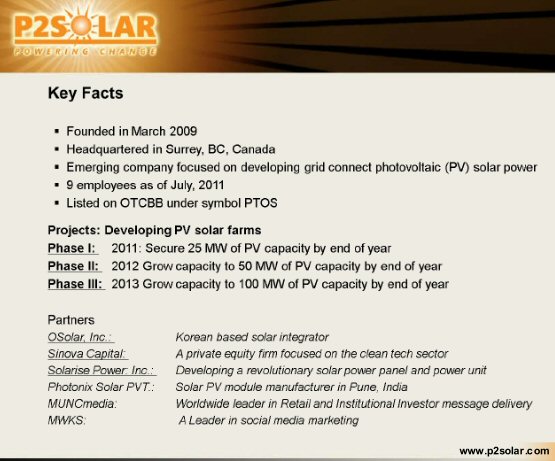
(source -- http://www.slideshare.net/p2solar/p2-solarpp-tpresentation-v38-8579794)
Jump to
Legal
Disclaimer
Boyd
speaks out on 1,000 w/m^2 limit
DBK
Solar screen captures (www.dbksolar.com)
Darry Boyd's patent application (discussion)(actual
filing)
GE solar
panel spec
Boosted
voltage circuit -- or how to fake 'Maximum Power'
How
to reliably test a solar panel
Resistive
load bank
Names,
pictures, addresses
DBK
Technitherm Ltd
Early
DBK fraud warnings
Address
is UPS post office box
Ties
to P2Solar (aka Lassen Energy)
Natco
announces Lassen Hybrid Solar Panel Receives Independent Verification
Natco
=> P2Solar
P2Solar's
new PR/investor relation firm
PR
firm indicates P2Solar to abandon Boyd's solar panel
P2Solar
re-embraces Boyd's phony solar technology
YouTube
video of DBK solar demo
P2Solar
partner companies
P2Solar
and Solarize part company
-----------------------------------------
Appendix
Astralux
Ltd (Ukraine) wind turbine scam --- DBK equivalent in wind turbines
---------------------------------------------------------------------------------------------------------------------
(update 7/2/13)
P2Solar
and Solarize part company
P2Solar's
recent 10Q filing (July 2013) contains the information about the super
duper (Boyd designed) solar panel. In 2010 Raj having nothing in the pipeline
went back to the old well (Boyd's panel) with the announcement that P2Solar
(Raj) and Solarize (Boyd) traded a million shares to form a joint company
to work on 'perfecting' (to speak loosely) Boyd's violation of physics
solar panel. The recent 10Q says they have been working for the last two
years to create a "working prototype" of the high efficiency, super duper
panel. And guess what, they failed! "All efforts have been unsuccessful",
says the 10Q. Really, it's comforting to find the laws of physics still
hold! Idiots....
So in May 2013 they just shuffle the shares around, "effectively reversing the transaction (between P2Solar and Solarise) that was consummated on September 6, 2010", says the 10Q. This 'transaction' between the companies, of course, never had any real substance anyways, so, of course, no money changes hands during the parting. And it is a parting (with a hedge), because the 10Q says, (once the agreement is finalized, somebody else always has to sign off, even months later) "the company (P2Solar) will have no further ties with Solarise or the panel it was trying to develop."
Current projects
The 10Q now
says the company is working to develop solar projects in Canada and India.
It has zero mention of Bulgaria where all sorts of extravagant predictions
about very large solar projects were made not so long ago, [Headline: "P2Solar
has said it will install a 7.3 megawatt (MW) photovoltaic plant in Bulgaria"
(July 2011]. Bulgaria is now forgotten. The (single) project in Canada
is covering the roof of one company building with a 53 kw solar panel array
(plus grid hook up). This is their first actual hardware project now (supposedly)
started and with half of the 160k total paid up front. This project is
roughly the purchase and installation of 250 large panels, which run about
200 watts each, plus inverters. With a guessimate of 10k for the inverters
this leaves 600 for each of the 250 panels to buy and install them. Of
course, this is all my figuring, P2Solar never gives any details about
the project.
What is P2Solar's contributions to this project. Damn if I know. This is never mentioned in the 10Q or any public announcements of the company. My guess is the printing company hired P2Solar (effectively their one engineer) to help plan the overall project, take some or all of the financial risk, and to handle the hassle of hiring and dealing with local solar contractors who are likely doing the work. Who picked out the equipment and ratio of capital equipment to labor costs is never detailed anywhere, nor I might add is their any guidance given on profit of the project, only its revenue.
The India projects are rights acquired to put solar panels over two (or three) canal site, but building this requires a lot more money than the Canada project and they, surprise (!) don't have the funding. The 10Q says they may try and raise the money by selling a new class of preferred shares (details TBD, of course) to a few private investors, which almost for sure, given the amount of money needed, would hugely dilute the existing stockholders, who never even seem to notice this (based on posts I see on their forum board). The 10Q also has some double talk that the Indian company they (supposedly) set up to build the canal solar projects, they don't actually own ("we do not have a direct ownership interest"), but because (in some way) they control it, they are going to consider it "our operating affiliate".
(update 10/14/2012)
YouTube
video of DBK solar demo
Not much going on
in the DBK Solar world this last year. On the P2Solar stock forum the super-duper
(Boyd) solar panel hardly even gets mentioned anymore, it just faded away
(gee, I wonder why?) However, DBK solar has a YouTube video that is worth
debunking. It has been up since 2008, but I just found it. It is titled
'DBK JIL-3000 Hybrid Solar Panel - 3,000 watts', and it shows a demo of
the (claimed) 3,000 watt panel, and has had more than 4,000 views.
http://www.youtube.com/watch?v=H0hM8TIMe0I
The 'inventor' Darry Boyd is probably either the man doing the demo or is one of the observers. The video shows a single 5 x 3 foot solar panel in sunlight powering several motors, identified as six 1/2 hp DC motors. The conversion from hp to watts is [1 hp = 746 watts], so it might appear that with six 1/2 hp motors spinning, the solar panel must be outputting [6 x 1/2 x 746 watts = 2,238 watts] or even slightly higher power when motor losses are accounted for.
Such a conclusion, however obvious it might appear, is wrong. Notice there is nothing connected to the shafts of the motors. Most of the electrical power that goes into a motor comes out as mechanical work, which is [Torque x speed]. Since there is almost no torque load on the motors (just the tiny drag of the bearings), the motors can spin quite fast on very little input current and power. A standard 5 x 3 foot panel of good quality can put out 200 watt (or more), and 200 watts is more than enough to spin these six unloaded motors. The proof that the motors will run on very little power is actually shown in the video. Notice there is (almost) no change in the sound of the motors when the demo man walks in front of the panel and puts it half in shadow.
The video is showing what is probably a real demo, but there is nothing remarkable about the panel's output power. Any good quality silicon solar panel can do this. The solar panel load in the demo (unloaded motors) has been chosen to deceive. If the panel is really putting out more power than it receives from the sun (in violation of Conservation of Energy!), then prove it, show the amps and volts at the panel terminals, don't run it with some mickey mouse motors as loads. As Carl Sagan once said, "Extraordinary claims require extraordinary evidence".
(update Oct 2012)
P2Solar partner
companies
In a July
2011 P2Solar presentation they listed their 'partner' companies.

(source -- http://www.slideshare.net/p2solar/p2-solarpp-tpresentation-v38-8579794)
OSolar is a Korean company that says it provides engineering for solar installation. This is the company that probably did the engineering for the solar projects that P2Solar has bid on, because none of the principals of P2Solar has any engineering background. The website 'www.osolar.com' is dead. Solarize Power, Inc (another of Boyd's panel companies) is a company P2Solar bought a large stake it, supposedly to keep their options open on Boyd's super-duper solar panel. In 2012 when I google the managment of Solarize Power in public records I find only Gurm and Hans. In other words they are partnering with themselves. Photonix Solar, however, does appear to be a real, if small, company in India that makes solar panels. Here's a picture showing the company starff from the Photonix Solar web site (I love this photo!)
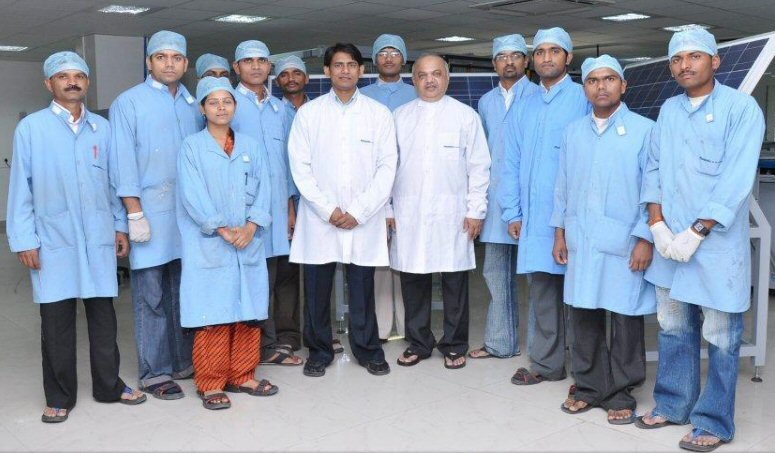
Photonix Solar staff
(source -- http://www.photonixsolar.com/gallery.html)
---------------------------------------------------------------------------------------------------------------------
Astralux
Ltd (Ukraine) wind turbine scam --- DBK equivalent in wind turbines (12/8/2011)
(3/23/13)
(update 3/23/13)
Astralux wind
turbine has morphed in the last couple of years, becoming even more like
DBK. Like dozens of other backyard inventors they have now built themselves
some hardware: a vertical wind turbine prototype of their design they rate
at 2 kw. So far so good, but there is a scamy side to Astralux too. The
strong claims made for the hardware are unsupported by data, and the claimed
features of its design are in many ways absurd. Overlay this with grandiose
and totally unrealistic plans to scale up the technology, and here is the
real red flag, trolling for naive customers on a related site with promises
of delivery for hardware they don't have (and almost for sure never will
have) with the requirement that customers pay 50% up front on all
pre-orders.
Here's the flavor of their claims, from their home page:
"We are ready to service orders for wind turbines up to 10 kW of power." Really? A x5 scale up is a stretch for company that apparently has only built a single 2 kw prototype, but perhaps not totally absurd, but the very next sentence we get this:Scam flags"In the future we will build a wind turbine plant that produces up to 1 GW of power that will soon become the basis of the wind power industry." Now we really move into the realm of the absurd, into fantasy land. While slightly hedged with "up to" for a 2-3 person company to state "we will build" a wind turbine that is x500,000 larger than they have every built and more than x100 times larger than any wind company on earth has every built is ridiculous.
* They claim as an advantage that while rated power is obtained at 10 m/sec wind (consistent with most turbines) as wind speed increases their output power continues to increase. They say x4 rated power at 15 m/sec wind and the turbine can be used to 40 m/sec wind. Since power in wind goes as the cube of speed, at 40 m/sec wind the turbine output power is potentially 4^3 = x64 times higher than rated power, and in fact we find graphs of the turbine's output power vs wind speed showing just this!!
Operating over a wide overspeed wind speed range (10 to 40 m/sec) poses an impossible engineering challenge in two ways. First, the conversion electronics cannot be economically designed to handle huge transient surges when the wind blow fast. Second, the actual windings in the generator can't handle huge overloads either. An wind speed increase from 10 m/sec (rated speed) to 40 m/sec presumably means the turbine would potentially rotate x4 faster, and with a PM generator this means x4 higher voltage. However they claim output power continues to increase in the overspeed range reaching x64 higher (!) at 40 m/sec. This is, of course, theoretically possible since power goes as wind speed cubed, but from an engineering point of view it is a nightmare. With voltage up x4, current must be up x16 to give x64 power, but there is a pesky little problem here with ohms law. A x16 increase in current means (ohmic) heating in the winding increases by 16 squared or x256! Can you say idiots or fraud?
* The Astralux site is dominated not by reasonable size turbines they could conceivably build, but by fantasy polished artworks showing monster versions of their wind turbine design on the landscape and mounted on top of skyscrapers.
Prepayment red flag
The
scam red flags really go up when on another site I find a release from
Astralux that includes this:

Note the text: "with 50% prepayment" !
Delivery: 100 kw in three months, when they have only
built a 2 kw prototype!
screen capture 3/23/2013
source --- http://pptymag.com/10mw-wind-turbine-quadruples-power/4730/
They are pricing a 20 Mw unit for 34 million dollars (US) with (get this) "with 50% prepayment". This is from a 'company' that business sites say is 1-10 people whose only hardware is apparently a single 2 kw prototype. A 20 Mw unit would be a scale up of the prototype of x10,000!! I know as an engineer this is not how engineering works, scaling up by x10 can be very difficult, and scaling by x10,000 is a joke. A release like above screams scam.
Astralux is saying advance us 17 million and we will deliver a 20 Mw wind turbine. Note a 20 Mw turbine is about x3 larger than the biggest turbine ever made by huge companies like GE and Siemens! Oh yea, your going to get a turbine if you upfront 17 million, and they have a bridge in Brooklyn you might want to bid on too. Another April fools joke or tolling for suckers? You decide. The 20 Mw turbine even has a "planned release date - end of 2015".
I note also on their main site one of the Astralux contacts handles "orders".
Delivery red flag
And to take
the fraud to another level above promises "3 months delivery time" for
turbines up to 100 kw, which is x50 larger than they have ever built. Oh,
yea!
-------------------------------------------
I happened
on Astralux Ltd vertical axis wind turbines (based in Ukraine) and noticed
right off their claims were absurd. In ten minutes I began to suspect I
had stumbled onto a scam, the wind turbine equivalent of DBK Solar. When
on another site I found their prices and "with 50% prepayment", in my mind
it went from being a possible joke/scam to an actual scam.
Red flags for a scamIt's uncanny how this Ukraine scam site tracks the original DBK solar site, like they used it as a model. DBK even had the same picture, three dorky guys standing beside a solar panel.
No real engineering, absurd pompous claims (works to winds of 88 mph), looking for an investor to build factories, all contacts in Ukraine, off the wall side claims (world's first wind powered car), 50% advance to pre-order. (The wind powered car is now claimed to be an April Fool's joke, well maybe, but dragging for money for so-called "pre-orders" is a classic scam tactic.)
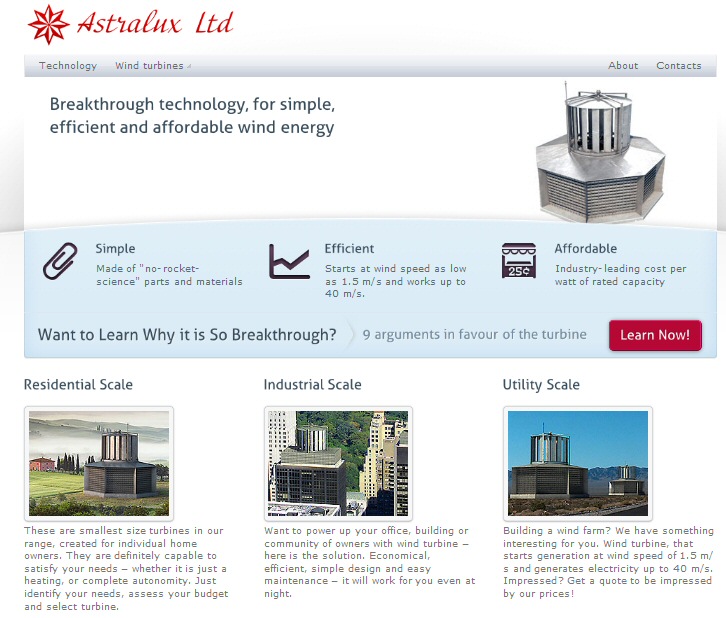
Astralux Ltd home page
screen capture 12/8/2011
source --- http://newwindturbine.com/
On the side they have designed a wind powered car! Why not pre-order one of these beauties, only 50% up front? Oh, yea.
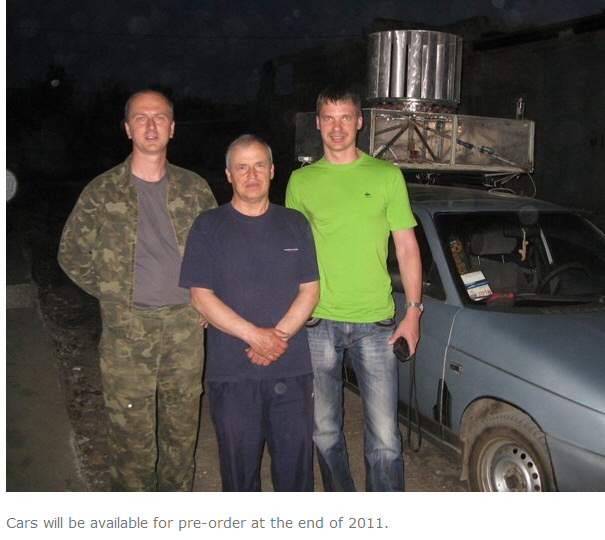
"First in the world wind powered car"
screen capture 12/8/2011
source --- http://newwindturbine.com/
As far as I can tell, I am the first one to identify this wind turbine company as a scam. It was mentioned in a Wikipedia wind turbine article, so I left a discussion note there that it was a possible scam asking others to take a look.
Later Astralux 'explained' the car wind turbine was an April fools joke. Well maybe, but if it was, how then to explain the picture caption: "Cars will be available for pre-order at end of 2011". Pre-orders normally imply money up front and for a non-existent product that smacks of scam.
==================================================================================================
(update 11/7/09)
Legal Disclaimer
All comments
and opinions in this essay are to be understood in the context of, and
as a response to, claims by several entities that they invented, tested,
have for sale, or are otherwise in possession of solar panel(s) whose power
out claims vs their size imply that they are operating with an efficiency
greater than 100%. Commercial solar panels at the present time have efficiency
in the 8% to 23% range. Much work is being done to improve solar panel
efficiency, but is there a theoretical upper limit? Well even without
knowledge of solar panel design it's possible to state one upper limit
with confidence --- No solar panel has, or will ever have, an efficiency
greater than 100%.
The 100% upper limit on efficiency is firmly grounded in physics, but it is also easily explained on a common sense basis. The technical reason that efficiency cannot exceed 100% rests on a bedrock principle of physics called Conservation of Energy. Almost all real power devices operate with an efficiency less than 100%, meaning the output power is less than the input power because some of the input power is lost, usually as heat. At 100% efficiency we have a perfect device with losses reduced to zero, meaning the output power equals the input power. At efficiency greater than 100% we have an imaginary device where output power exceeds input power. This sounds unreasonable, and it is! Conservation of Energy forbids power from being 'manufactured', so there is no source for the 'extra' power in the output.
In the case of solar panels the input power comes only from the sunlight hitting the panel. To calculate the power in sunlight requires knowing two things: solar spectrum from infrared to ultraviolet, i.e. the brightness of the sun at each color, and knowledge of how the power carried by light varies with color. The power of light and how it varies with color was figured out by Einstein and others top scientists more than 100 years ago. The power in sunlight and the nature of the solar spectrum are extremely well known because the sun has been monitored by satellites for years. Satellites looking directly at the sun above the earth's atmosphere measure the average power in sunlight as 1,370 w/m^2 (watts per square meter). When losses in the atmosphere are accounted for, the power in bright sunlight on the earth's surface is about 1,000 w/m^2.
1,000 w/m^2 is a value well known in the solar photovoltaic industry. It appears on every solar panel data sheet and is the standard light intensity at which solar panels are tested and rated. In fact the patent application of Darry Boyd, CEO of DBK Solar, Photovoltaic Cell A Solar Amplification Device, filed Mar 2, 2006, demonstrates he too knows about 1,000 w/m^2. His patent application says, "The sunlight wavelength spectrum can produce up to 1,000 watts of energy per square meter when striking the earth's surface." (paragraph 0003, emphasis added)
For a 5 ft x 3 ft solar panel with a collection area of 1.4 m^2 the power coming in from bright sunlight at the earth's surface, assuming mirrors or lens are not used to concentrate the light, is thus [1.4 m^2 x 1,000 w/m^2] = 1,400 watts. Any claim of more than 1,400 watts out of a 5 x 3 ft solar panel is thus equivalent to claiming that more power comes out than comes in! It is a claim the efficiency of the solar panel is greater than 100%. This simply cannot be true according to the law of the conservation of energy. (For reference, a typical commercial 5 x 3 ft solar panel puts out about 200 watts, meaning its efficiency is about 14%.)
The use the work 'Scam' in the title of this essay, and other comments and opinions in this vein, are thus, I believe, fully justified when applied to businesses or individuals that represent themselves to be in the solar business and who claim to have invented, tested, have for sale, or are otherwise in possession of 5 x 3 ft solar panel(s) that can output more than 1,400 watts (as DBK Solar and other entities have repeatedly done). This is achievable only by solar panel(s) with efficiencies greater than 100%, which is impossible. Further justification for rejection of such patently false power claims is that invariably there is no mention that for a 5 x 3 ft solar panel to output more than 1,400 watts it must be operating with an efficiency greater than 100%, nor is any explanation ever offered as to how the laws of physics have been circumvented to achieve this!
My only purpose
in writing this essay for my home page has been to document and expose
how non-existent 5 x 3 ft solar panels with claimed power outputs of 1,400
watts and higher (equivalent to claiming efficiency greater than 100%)
are fraudulently marketed to potential customers, dealers and investors.
(update 11/5/09)
--------------------------------------------------------------------------------------------------------------------
How to build a perpetual power source!
-- (Using a DBK a 3,000 watt (1.4 m^2) solar panel) (11/7/09)
Below a simple proof
as to why a 5 x 3 ft solar panel with 3,000 watts output (claimed by DBK
Solar and other entities) cannot exist. If a 3,000 watt 5 x 3 ft
solar panel did exist it could in principle be converted into a
perpetual
power source. The key is to recognize that any device claiming
to output more power than it needs in input power to run can in principle
power
itself. A fraction of the output power can be fed back to the input
with the remaining fraction available to do useful work. Here are the steps
in detail to make a perpetual power source from a 3,000 watt 5x3 ft solar
panel.
Need a 50% efficient lights with a solar spectrum. (50% efficient lights don't now exist, but there are no
theoretical reasons why they can't be built someday.)
1) Put panel in sun. It puts out 3,000 wattsThis is what the mathematicians call a reductio ad absurdum (reduction to absurdity) proof, and they consider it a rigorous proof. You make an assumption (3000 watt 5x 3 ft solar panel can exist). Show it leads to an absurdity or contradiction (operation at > 100% efficiency allows perpetual power source to be built). Therefore the original assumption is false (a 3000 watt 5x 3 ft solar panel cannot exist).
2) Take 2,800 watts and feed into 50% efficient lights, which put out 1,400 watts in photon energy
(Solar equivalent, same optical power as sunlight falling on 1.4 square meter)
3) 200 watts are available to do useful work
4) Substitute lights for sunOnce it starts sunlight is no longer needed, the solar panel is self powered and will run forever!
Presto/chango a perpetual power source. Power comes out of nowhere, the world's power problems are solved!!
Hang a motor on it you have a perpetual motion machine too!
"A little about the main principal, my name is Darry L. Boyd Sr. I have been in the energy business now for over 30 years. DBK was created to be a legacy company with its intended focus on helping others.My opinion of the above statement: total jibberishI fully understand the light 1000 W/M2 principle. There is a paradigm-shift in technology to the photosynthesis effect on constructed solar panels which in no ways violate this principle."

source: http://dbkcorporation.com/about/about.htm
(screen capture 2/16/2010)
(Title: Accepting orders - order today. Tentative delivery schedule)
Feb 2010
Filled
March 2010
Accepting
April 2010
Accepting
So here we have a claim that as of this month (Feb 2010) orders (presumably for the JIL-3000 solar panel) have been "Filled".
Oh, and the
'waiting list' scam is back. Earlier Boyd wanted 10% down, but in the above
site the deposit to get put on a waiting list is 50% of the panel price,
a measly $17,898 dollar/panel ( 'certified check' only). Oh, yea!
-----------------------------------------------------------------------------------------------------------
Boyd's 3,000 solar panel (JIL-3000) has a DC-DC converter
(2/16/10)
I recently
had an idea consistent with Boyd's spec for his JIL-3000 solar panel (his
3,000 watt solar panel). He claims output of 220 VDC (or 240 VDC) and 14A
DC and specs that the panel either contains or has attached a DC-DC inverter.
Boosting Pmax to 3,000 watts
My idea is to put
in series with a convention panel output a small (few cubic inches) high
voltage, low power battery powered oscillator coupled into the panel output
with a full wave diode rectifier. (Go here
for a sketch of how my 'Boosted Voc' DC-DC would work.) Such an oscillator
could easily boost the Voc (open circuit voltage) of the panel to the required
220 to 240 VDC. If a 7A panel was reconfigured to put two of its cell strings
in parallel, this could explain the 14A. In other words a conventional
36V, 7A panel is rewired to become an 18V, 14A panel. Then the Voc booster
DC-DC is added in to increase Voc to above 200V. Of course the actual power
of the panel (about 200 watts) is pretty much unchanged, but its
'Maximum Power' as defined by IEC 61215 solar standard (Pmax = Voc
x Iss) would in fact come out to be in excess of 3,000 watts! No proof,
but it fits all the facts.
=====================================================================
Introduction
For two years
a USA solar panel manufacturer has been making a claim that violates the
laws of physics. They claim to have a 3,000 watt solar panel that outputs
2.3 kw/m^2, whereas the total power in bright sunlight is 1 kw/m^2 (approx
@ earth's surface). In other words they claim to have a power conversion
device (solar panel) that can continuously put out more power than
it takes in (efficiency > 100%) somehow circumventing the law of the Conservation
of Energy. Some claim! Carl Sagan's oft quoted comment comes to mind: "Extraordinary
claims require extraordinary proof". For reference conventional solar panels
that size in bright sunlight output about 200 watts or 140 watt/m^2 (14%
efficiency).
Here is the true story of how I stumbled onto a million dollar solar scam/fraud, and how I pried open a look at the underlying crackpot physics when I discovered a recently published patent application by the DBK president.
Over the two years I have followed this scam the fraudulent 3,000 watt solar panel has mutated from an internet scam (DBK Solar => Lassen Energy), both run by the same man, into the public domain in the form of SEC registered penny stocks (Natco International => P2Solar, OTC symbol 'ptos'). This is a fraud that the law somehow does not seem to be able to shut down.
Beginning
I stumbled
upon DBK Solar, a manufacturer of solar panels for homes, quite by accident.
A local solar installer had a booth at a local fair in the fall of 2007.
In their booth they had a large solar panel (5 ft x 3 ft, approx) that
was marked 3,000 watts. At the time I basically knew nothing about solar
panels, but as a power engineer I knew 3,000 watts was quite a bit of power,
so being curious I dropped in and asked, "How many amps and volts?"
The man in the booth said he didn't know, saying the technical guy had
just stepped out, so I picked up a sheet on the 3,000 watt panel and left.
Unfortunately I did not really look at the panel.
What, 3,000 watts?
It didn't
take too long to realize that DBK's 3,000 watt panel was barely believable.
Technology almost always evolves incrementally. If a new panel to the market
can put out 10%-15% more power than competing products, then it's a significant
technical advance and should be a strong product. DBK was claiming their
panel puts out x18 (1,800% !) more power than competing panels the same
size. Maybe a misprint, did they mean 300 watts? Nope, they state flat
out you can replace 18 competing panels with one of theirs. DBK's web site
on first glance looked real and (sort of) impressive. I was puzzled. This
was either a world class breakthrough or a major scam.
Beyond the laws of physics
The clincher
that this was a scam soon came from physics. Having previously studied
up on global warming, I knew that the total power of sunlight at the earth
in space (above the atmosphere) is 1,370 w/m^2. When losses in the atmosphere
are accounted for, the max solar power at the earth's surface (sun overhead,
no clouds) is roughly 1,000 w/m^2. A little math showed the collecting
area of the DBK's 3,000 watt panel is about 1.3 m^2 = (1.74 yd x
0.90 yd x 0.836 m^2/yd^2).
Hence even if every single photon from the sun (at every wavelength) was captured and converted to electricity (an impossibility), the most power the DBK panel could put out, assuming mirrors are not used to concentrate the sunlight, is 1,300 watts = (1,000 w/m^2 x 1.3 m^2). This would be for a panel that's 100% efficient. Most commercial solar panels this size put out about 200 watts (or a little less) for an efficiency of (200 w/1,300 w x 100%) = 15%, only a little better than solar cells of 40 years ago.
Doing a little web surfing I found that what I had figured out about DBK Solar in fall 2007 others had figured out a year earlier. Goggling DBK Solar and scam brings up a bunch of hits. Anyone who knew anything about solar panels knew something wasn't right here. One guy was so upset he started a web site called Solar Scam.
Scam to fraud
A claim of
3,000 watts indicates it is clearly a scam, but it's not a minor scam of
the Ginsue knife variety. Each of these panels sells for $22,000! They
are pieces of capital equipment. It would be more accurate to call this
a major fraud.
A further conclusion is that these 3,000 watt panels do not exist. You cannot make what the laws of physics forbid, and you cannot deliver what you cannot make. DBK in their two years of existence has obviously not manufactured or delivered a single 3,000 watt panel. Nor has the panel been photographed, tested, or approved by anyone, contrary to their claims.
How does this scam work?
If your stupid
enough, or gullible enough, you can order panels direct from DBK, and they
will take your money. Of course, they demand 10% of the final cost up front,
that's $2,200 up front per panel folks, to get put on a (so called) "waiting
list". Not to worry though, the 10% deposit is labeled as "refundable".
Good luck on getting a firm delivery date!
From DBK's web site (see screen captures below) it appears that what DBK is primarily doing is selling dealerships. DBK is the scammer, the dealers are the scammees. My local DBK dealer (as of fall 2007) had his own web site (Solar Edison LLC) and the only panels that he indicated that he sold were make by DBK Solar. His site said he had been active at fairs and shows for months (pushing DBK panels), which appeared to be true. Rechecking his web site in March 2008, I find all mention of DBK Solar is gone. Now under products on his site I find only this, "Solar Edison represents a number of PV component manufacturers". (I had advised him months earlier via email that DBK Solar was a scam.)
I've had email correspondence with another DBK dealer, who had been to DBK in Calif for training and told me some interesting stores. I tried to convince both DBK dealers that DBK panels could not possibly put out 3,000 watts hence DBK must be a scam, but clearly failed with my email correspondent. He is a true believer, hoping to make a million dollars (a week!) and promising to send me newspaper clipping when the technology hits the papers. Big bucks must be involved here, because DBK dealerships are being sold worldwide. I found a web site of a DBK solar dealer in Kuala Lumpur, Indonesia.
Dealer demo story
One DBK Solar
dealer with whom I communicated via email told me about his trip to DBK
Solar headquarters in Calif where he went for training. He said most of
the time was spent discussing contracts, but he and the other dealers were
taken to see the factory, and what they were all waiting for, a demo of
the 3,000 watt panel.
First, the factory. They were driven, he said, to a large, impressive factory building and looked inside. It was empty. This they were told was the building that DBK Solar was negotiating to rent to make the production panels. (Everything with DBK Solar is either planned, proposed, will be or coming real soon!)
Second, the demo. I was very curious as to how they could demo something that can't exist. Here is the story I was told by the DBK dealer.
He said they rolled the panel out on a push cart in a warehouse under a skylight, and while still inside the warehouse under the skylight panel power output was already about 2 to 3 thousand watts. Wow! They then rolled it outside, and even though it was cloudy day and they made no effort to orient it toward the sun, the power output increased to 4 to 5 thousand watts. All the dealers were incredulous, he said! Why, the dealers asked, are you rating this panel at only 3,000 watts? We want to be conservative, DBK told them.I asked if the trainers seemed like con men. His answer was no, they seemed like (geeky) engineers.I asked in a followup email if the panel during the demo was connected to anything (a load). The answer was no, they just used meters to measure the power. Some of the dealers he said had even brought along their own power meters.
How did they do it?
Assuming the
DBK dealer was telling me the truth, and I think he was, then the question
is how did they do it? How did they convince these new dealers that the
panel was either putting out thousands of watts, or was capable of putting
out thousands of watts? I have two ideas.
No load power measurement
If the panel was
not connected to resistors or light bulbs (a 'load'), then the panel was
not actually putting out any power at all. For a panel to put out power
there must be someplace for the power to go. A bare panel will have
a voltage, but no load means no current, hence no power coming out (P =
I x V). However, even without a load there is a way to get a rough measurement
of the panel's power capability.
To measure power (capability) without a load the voltage is measured (unloaded), and then the panel output wires are shorted and the current is measured. You get power by multiplying the voltage times the short circuit current. Typically this power number will be a little on the high side, but it is in the ballpark. A 200 watt GE solar panel, when measured this way, yields 266 watts (see spec below), 33% higher than the 200 watts it can actually put out.
First idea -- thin batteries
I was told
the panel was pretty thin with a bottom covered in plywood. The simplest
way I can think of to fake high power is to hide some thin batteries under
the panel. Typically the leads only need be shorted for a second or two
to read the current, so it wouldn't take too much battery to get high current
for a reading. High voltage batteries might also have been switched in
to boost the open circuit voltage reading. Some skill, and likely additional
(hidden) switches to switch batteries in and out, would probably be required
to make it appear that the panel power was responding to the illumination.
Second idea --- Series/parallel switching
Another idea
I had was to add switches (hidden in back) to modify a conventional panel
by changing its cells back and forth between series wired and parallel
wired. In a normal solar panel the 60 to 72 silicon diode cells are all
in series. The same current (5A to 8A) flows in all the cells and voltages
of all the cells add up. However, it might be possible to modify a conventional
panel so that groups of its cells could be switched back and forth from
series to parallel.
The idea would be to measure the voltage with the cells switched in series, and measure the current with the cells switched in parallel. In parallel mode the current of the cells will add. DBK claims their panel puts out x18 the power of a conventional panel. Looking at the online pictures of their test panel it looks like it has 72 cells. Suppose they hid 18 miniature series/parallel toggle switches in the back that were each wired to groups of four cells. Switching groups of four cells into parallel would increase the panel output current x18. (Of course it also reduces the output voltage by 1/18, but in parallel mode the voltage is not measured.)
If each group
of four cells was putting out, say 5A, then in parallel mode the meter
would measure 90 A = (5 A x 18). Mirabile dictu, the power reading of the
panel appears to have been increased by a factor of 18, just like DBK claims!
A further advantage of this approach would be that the panel power would
appear to change in a natural manner as panel illumination changed, but
with all the power readings x18 higher than normal. Just an idea. I have
no evidence that this is how it was done, but the integer relationship
between 72 and 18 is suggestive.
----------------------------------
(update 11/09)
Replace the x18 mechanical switches with transistors
The more I
think about the series/parallel trick the more I like it. What really makes
it clean is to replace the 18 mechanical switches with electronic switches
mounted on small PC boards. The PC boards would be hidden under the panel
and would be totally quiet. All that is needed to switch the panel from
series to parallel mode is a single pressure sensitive mechanical switch
under the backing. It would toggle all the electronic switches together.
As long as the back of the panel remained hidden, this trick would be virtually
impossible to detect.
Making a little
PC board is not difficult. Most technicians (or a talented HS student)
can do it using kits you buy at Radio Shack. What's needed here is the
same circuit x18, so it could be implemented with 18 identical little boards.
A mechanical DPDT switch can be replaced by a quad optical coupler that
controls four small, high current MOSFET transistors that do the actual
switching of the 5A from the cells. Small batteries are needed to power
the MOSFET gates, but these batteries have virtually no load so they are
small and can be mounted on the PC boards.
----------------------------------
Third idea ---- Use a capacitor (4/5/08)
A poster in
2006 on the Energy Portal (see below) suggested another, quite simple,
way the power reading could have been faked. If a large capacitor was connected
to the panel output, it would be (slowly) charged to the voltage of the
panel. When the panel (with parallel connected capacitor) is shorted to
get the current reading, there will be high current pulse for a fraction
of a second as the capacitor discharges. Most meters can be set to measure
peak currents and 'hold' the value. When such a high peak current reading
(mostly from the capacitor discharge) is combined with the open circuit
panel voltage, the result will be a greatly increased (and erroneous) power
capability for the panel.
----------------------------------
Fourth idea
--- Boosted voltage circuit -- or how to fake 'Maximum Power'
(2/16/10)
IEC standard
for solar panels (IEC 61215) has a test called Maximum Power, which is
defined as the product of open circuit voltage (Voc) and short circuit
current (Iss). Essentially it is the rectangular corner of the IV curve
of a panel and is easily measured with a simple meter. Actual power of
the panel is generally between 70% to 80% of Maximum Power. The difference
between these two powers is not apparent to most unskilled observers, allowing
in a demo situation Maximum Power to be passed off as the power of
the panel. This opens up an interesting way to fraudulently 'boost' the
power of the panel. I have sketched up how this can be done.
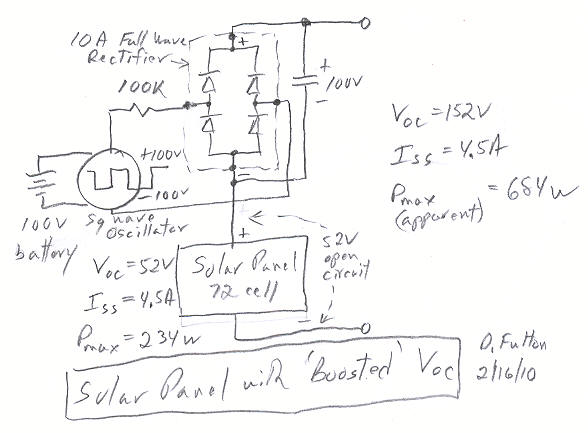
The trick is to hide away a little square wave oscillator powered by a high voltage, but small low power battery. Insert in series with the solar panel a full wave rectifier (10 A rating, panel+ to rectifier-) and apply the oscillator through a large resistor (100k) to the rectifier AC terminals. Now when the Voc is measured the meter sees the battery voltage added to Voc of the panel. The 100k here has little effect since the input resistance of most meters is 10 Mohm. The Iss of the panel is unaffected as it just passes through the two rectifier diodes, and the 100k coupling resistor protects the electronics and battery during the short. The indication of this type of fraud would be an anomalously high panel voltage. The apparent panel power could easily be boosted by x3 to x6 or more this way. I have heard reports of DBK demos that have this signature (150 VDC to 208 VDC from the panel).
With the rectifier in place the panel can still power loads (like motors) too. It retains about 95% of its real power capability; output current is unaffected and voltage drops about 5% (36V to 34V).
How to reliably
test a solar panel (2/18/2010)
DBK has been
doing demos of its solar panel to prospective dealers and investors for
several years. P2Solar has licensed rights to the Boyd/DBK/Lassen Energy
solar panel and in press releases P2Solar has described a few of the details
of its test of the solar panel. On the P2Solar site there are photos of
a panel demo (see below).
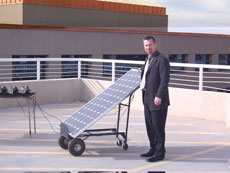 .
. 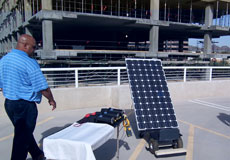
DBK panel demo on P2Solar site
(screen capture 11/2009)
(source -- http://www.p2solar.com/index.php?option=com_content&view=article&id=55&Itemid=58)
While it's a little hard to see in the photos above, there are several motors on the table that are used as loads for the panel. Other reported loads used in the DBK panel demos are 500 watt incandescent (quartz) lamps. Motors are deceptive loads because they can spin fast on relatively little power, much less power than the nameplate watts. The reason the power of an unloaded motor is low is this: Most of electrical power that goes into a motor comes out as mechanical power, which is [torque x speed], but when there is no connections to the motor shafts as here, the torque is low, just the drag of the bearings. Hence even though speed may be high the electrical power drawn by the motor is quite low (5 to 15% of nameplate watts). High power lamps are also deceptive loads, because it's very difficult to judge when looking at a high power lamp to know whether it is running anywhere near its rated brightness and power.
Resistive load bank
for solar panel test (2/18/2010)
Do Boyd's
panel demos using unloaded motors and high power lights for loads verify
his 'new' solar panel technology? They do not. In principle they could,
but then the verification would depend solely on the measurement of power
being accurate. But power, being the vector product of two parameters (I
and V), is inherently tricky to measure and unskilled observers can be
deceived.
I propose that a reliable way for Boyd to verify that his panel can output high power is to load the panel only with resistors. Here all the electrical power output by the panel is dissipated as heat, and sustained high heat can't be faked. Boyd claims his JIL-3000 panel will output 3,000 watts. 3,000 watts is a ton of heat, the same amount of heat as two 1,500 watt room heaters put out. If you lean over a set of resistors dissipating 3,000 watts you will be roasted with the heat pouring off of them. If this high power is sustained, say for 30 min to an hour, it would exhaust even a 40 to 70 lb hybrid car battery, so hidden batteries are not a problem.
A suitable resistive load bank can be build in a few hours with 200 dollars or so of materials. A resistive load bank usable from 36V to 240V, up to 1,000 watts or more, can be built from twenty-five 100 watt resistors (25 ohm, 100 watt, +/- 5%, wire wound, tubular such as Vishay/Dale HL10006Z25R00JJ, sold by Digikey as HLC-25-ND, $150 dollars for quantity of 25) mounted on a piece of plywood.
One advantage in this type of load is that current is proportional to voltage (I = V/R), and, unlike with lamps, the resistance of wire wound resistors is stable. It doesn't vary with temperature. You can measure it when cold and it will be the same when hot. With a stable resistor you can use ohms law to confirm the power using [P = VxV/R] to verify [P = V x I]. Both should give the same watts. R can be measured using the ohm scale of the meter (when the bank is not connected to panel) and it should agree with ohm calculated from a formula. Even if Boyd's panel, which he specifies includes a DC-DC converter, contains an AC component, the use of a True RMS meters to measure current (or voltage) will provide an accurate reading of the total power (DC + AC) coming out of the panel.
The way the load bank is used is this.
As the test proceeds the number of the resistors powered is varied. You are looking for the ohm range where the solar panel is fully loaded. If the current is maxing out but voltage seems low, then the panel is overloaded, so the idea is to increase the ohms of the bank by removing resistors 'one at a time'. If it's the opposite, the voltage is maxed out, but the current seems low, then the panel is underloaded, so the idea is to decrease the ohms of the bank by adding resistors 'one at a time'. At each step you use your calculator to figure the power. If you are measuring voltage and current, [Power = V x I]. If you are measuring voltage and resistance, [Power = (V x V)/R]. You can use a power meter, but you don't need one, a simple (V, I, Ohm) meter will do the job. In fact the best way to do it is use two meters that you leave connected all the time, one measures the voltage at the terminals of the panel and the other measure the amps coming out of the panel.
You walk the number of resistors in the bank slowly up and down looking for the maximum power reading. This whole process shouldn't take more than an hour. Once the maximum is found you let it run a while (30 min or more) with the meters connected to be sure the power is stable and continuous.
You remove resistors by cutting them out and add resistors by wiring them in. It might be tempting to connect them in using just wires twisted together, but this will compromise the test. The resistance needs to be stable. Connect the resistors together with hookup wire and soldered connections. You can buy what you need to do this at your local hardware store {wire cutter, 25 ft of hookup wire, big soldering iron or gun, solder}
The resistors are going to get hot and for convenience and repeatability should be mounted on something an inch or two apart. (A tangle of wire and resistors can be thrown on the ground, but for a quality test they should be mounted.) A simple mount is just a big piece of plywood. You can buy mounting hardware for these resistors (they are hollow tubes), but simpler is just screw their terminals directly to the wood. (Dry wood is a pretty good insulator.) Another approach is staple the (insulated) interconnect wires to the wood and hang the resistors from the wires. (The wood may brown up a little from the heat, but this doesn't matter)
If the panel voltage turns out to be low, 36 to 50 V, which is typical of 72 cell panels like that seen in the photos, then the resistors are wired in parallel. If the panel voltage turns out to be high, 220 to 240 V, boosted by a DC-DC converter, then they are wired up in series or what is called series/parallel. With knowledge of the expected output voltage the resistors can be prewired in advance of the test, which will greatly speed the test.It will take a few hours to built the panel, but it gives you a reusable stable, quality load bank that can be used again and again. All the panel power will be converted to heat and sustained high power heat can't be faked. Instrumentation is simple, no power meter required, and with a resistive load power can be measured multiple ways for confirmation. Even a mixture of AC + DC outputs can be accurately measured by use of True RMS meters.
If Boyd's panel could demonstrate sustained high power output at the watts he has specified, assuming reliable instrumentation, then if would provide verification of his technology. All that's needed is one working panel, this resistive load bank, a couple of good meters and one sunny afternoon. Will Boyd agree to it? Why would he not? If he doesn't agree to this test, I would walk away.
Perfect scam?
How can such
a fraud continue for two years in the USA? It's very disturbing that the
law has not shut this down. (I myself field a complaint with the state
attorney general, but never even received confirmation that it had been
received, much less acted on.)
What bothers me is that these DBK scammers may make a clean getaway. They delay and delay making any deliveries, raking in as much money as they can from dealerships and wait-list fees, and then they will probably just declare 'bankruptcy', closing the scam and leaving everyone holding the bag.
DBK blog postings
I found the
following three blog postings (on two different sites) about DBK dealer
relationships that are very revealing.
I sent DBK my $4000 and then asked for my money back. The president Darry L Boyd Sr. put in writing that I would have my money back in 10-12 days. That was 4 months ago. They will not return my money and I know that they do not have any solar panels that work. (posted Dec 2007)George W. Penington said at August 11, 2007 12:39 PM:
New Solar Photovoltaic Cell Efficiency Record: 42.8%. The engineers at DBK Engineering www.dbksolar.com have proclaimed a FIL 3000 watt solar panel that is 70% efficient since 2005. They have stated that they don't care if anyone believes them or not, they perform demonstrations for interested investors that walk away unshakeable in their beliefs in these 50 lb. 1.3 sq.ft. meter panels. At their last demonstration the panels powered two 1850 watt hairdryers with the panel propped up in the shade of the afternoon. The watt meters showed they were producing 2800 watts plus with out any loading. Two of my partners flew from the east coast to California to attend this demonstration and are convinced that the Company and the panels are real. They are prepared to order one (since one replaces 18 of the nearest competitor's panels) at the cost of over $10,000.00. Also the franchise fees are $4,000.00 to reserve an area code and then $100,000.00 when you have sold $1,000,000.00 worth of systems. I will give anyone that can prove to me, so that I can prove to my partners, a $1,000.00 (One thousand dollars) that these panels and the company are a scam. If no one can do it, then I will join them and laugh all the way to the bank. If they are proven to be real then I will eat a dead crow live on U Tube after a public announcement and apology. ps. I am building a website this weekend with all the research that I have done so far. www.solarscams.com but none of it is definitive proof one way or the other. OH yea! They stated they are not interested in the Nobel Prize. George W. Peningtonhttp://www.futurepundit.com/mt/mt-altcomments.cgi?entry_id=4418
Michael Flynn said at September 12, 2007 08:26 AM:
I visited DBK Solar in Carlsbad for a training session. They didn't get into the technical aspects of the product. They didn't get into the installation aspects either. They did show us a panel that produced 4100W indoors under a skylight and 5100W outdoors in the parking lot on a cloudy day. They downplay the output, encouraging us to stay conservatively at 3000W. I brought my own meter just for my own piece of mind. I'm not an expert, but don't you need a load to get an accurate reading of the power generated? We visited a very impressive facility that they were negotiating a lease on but they have not moved into it yet, after 6 months. I did purchase a dealership, on a gamble, and have kept in touch since. They have applied for certification in California and Florida has agreed to rubberstamp whatever California does. I can't sell the systems in Florida without the approvals, you can't apply for the rebates without approvals. The company is very secretive and odd, but I haven't given up yet. ndxtrader7@aol.comDBK patent application!
Yikes, this is a patent application describing DBK's 3,000 watt panel! I have downloaded it and read it. This patent application is self filed by the inventor (Boyd) without a patent attorney. It was filed on March 2, 2006, which is the month DBK announced their 3,000 watt panel. Here is the US patent office link to it.
US Patent Application No 20070204899
Photovoltaic
cell solar amplification device
It starts by showing (prior art) a conventional 5 x 3 panel rated at 165 watts with 36 cells each 6.6A. DBK's panel "Solar Integrated Circuit" is shown with the main solar cells wired to an integrated NPN transistor that (magically) multiplies the output current of the cells. The is referred to as "solar energy amplification"! The NPN transistor current gain (beta) is described as typically 25 in the text, and in the figure the output current is shown as the 6.6A multiplied by 25 (Iout = 25 x 6.6A = 165A). The power rating of Boyd's 5 x 3 ft panel is shown as 2,970 watts = (165A x 18V), where 18V is 36 cells at 0.5V/cell.
The application is very short and vague as hell. Four different band gaps are supposedly being used to absorb visible, ultra violet, infra red and deep infra red. There is zero information as to how this is done, no material information, no doping profiles, no nothing. The circuit configuration (with the NPN) makes absolutely no sense. The application starts by stating (correctly) that the solar spectrum has 1,000 watts per square meter, but how this absolute power limit is bypassed goes completely uncommented on.
On top of everything else the patent application contains the most astounding typos It looks like it was never even proof read. For example, fig 3 has the Max Power Current = 1,320 amps (was supposed to be 120 amps)! In the text instead of the clearly intended photon the word is proton. Here's a typical sentence "The proton with this wavelength strikes the semiconductor dope electron and hole layers creating an electro magnetic electric field across the junction."
Review of DBK's patent application
Basically
what Boyd is claiming is that by integrating a bipolar transistor with
a current gain of 25 into a solar panel he can multiply the current
coming out of the cells by the current gain of the transistor (6.6A to
165A), and do this with the panel voltage remaining (nominally) unchanged.
(Boyd appears to incorrectly use the unloaded voltage of 0.68V/cell for
his conventional panel and the correct loaded value of 0.50V/cell for his
new panel.) The huge increase in panel current to 165A combined with the
voltage dropping (for unexplained reasons) from 25V to 18V gives a power
increase for the panel of 18. (165 watts x 18 = 2,970 watts). A x18 power
increase is totally consistent with DBK's marketing claim that one of their
panels replaced 18 conventional panels.
The physics and engineering in this patent application are complete and utter nonsense, total gibberish.
There's nothing subtle about this patent. It's the electrical equivalent of a perpetual motion machine. For every 1,000 watts the sun puts in Boyd's invention with its solar energy amplification puts out 2,300 watts!Having never met the man, I can't be sure if Darry L. Boyd is a con man or a crackpot. It may be that Darry L. Boyd is a very clever and just threw this patent together to convince the rubes he has new technology. I can imagine him waving it around at dealer trainings. However, this patent application has all the hallmarks of a true crackpot: Self written, vague as hell, shows only a cursory understanding of solid state physics, and basic violations of the laws of physics are ignored.
My guess is that Darry L Boyd is a crackpot inventor and may in fact have convinced himself that he had made a huge breakthrough. It explains a lot about DBK. I can see him saying to himself, now all I have to do is work out the details. And he apparently wanted the patent application published (on the patent office web site), because he paid the patent office's $300 publishing fee.
However, there are glaring inconsistencies, which should be obvious even to a crackpot. DBK has always concealed the amps and volts of their panel, which is the question I asked at the DBK fair booth. The panel output voltage is now revealed in the patent application to be only 18V. Yet DBK markets one of its panels mated to various (DC to AC) inverters all of which require a minimum input voltage of 150 V. The pairing obviously cannot work. This just shouts fraud.
Power amplification claim
Boyd in his
patent application claims he has invented, "A method for power amplification
of photovoltaic generated source." What crackpots, like Boyd, don't understand
is that in an isolated system (like a solar panel) it is impossible
amplify power. You can't get out more power than the sun puts in, period,
it's impossible. To claim otherwise is the electrical equivalent of claiming
to have invented a perpetual motion machine!
But a crackpot might retort, 'A transistor can amplify current (true), and a transistor's output power can be higher than its input power (also true), therefore isn't it obvious that transistors can amplify power?' Well maybe to a crackpot, which might explain why Boyd has a transistor (NPN structure) integrated into his solar panel, but real engineers understand that what is really going on is that the power in a transistor's output comes from an external power supply.
A look at the DBK
Solar web site
This section has
a bunch of screen captures from DBK Solar's site (http://www.dbksolar.com).
Most were captured on 3/5/08. Here is the DBK 'Welcome' (sounds impressive,
no?). Notice they "unveiled" their 3,000 watt panel in March 2006, so we
are now about two years into the scam/fraud.
"DBK is a designer, manufacturer and builder of alternative energy systems: solar panels, solar systems, fuel cells, solar based fuel cell generators and solar based fuel cell power plants in California, America and throughout the World. We design, build, package and install module solar power plants, solar based fuel cell generators and solar systems for homes and the commercial sector. Our focus is on reducing the cost of using and producing electric energy to our clients. DBK is your one-stop provider for your clean fuel (solar) energy needs."
"DBK’s technologically advanced solar electric power products (solar cell systems, solar based fuel cells, and solar based fuel cell generators) offer high quality and customer value. They are all based on crystalline silicon, the material of choice for efficiency and reliability for more than 25 years. In March of 2006, DBK unveiled the world must efficient and powerful solar panel 3,000 watts. We are going to be offering a full line of photovoltaic (PV) cells, solar modules, fuel cells and complete packages for residential, commercial and industrial systems."A few days earlier I had seen some downbeat language on the site, saying progress had been slow, but they were still fulfilling orders (for what they never say!). It sounded like they were laying the groundwork to close the scam by going 'bankrupt', but when I went looking to screen capture this language, I found it had been removed.
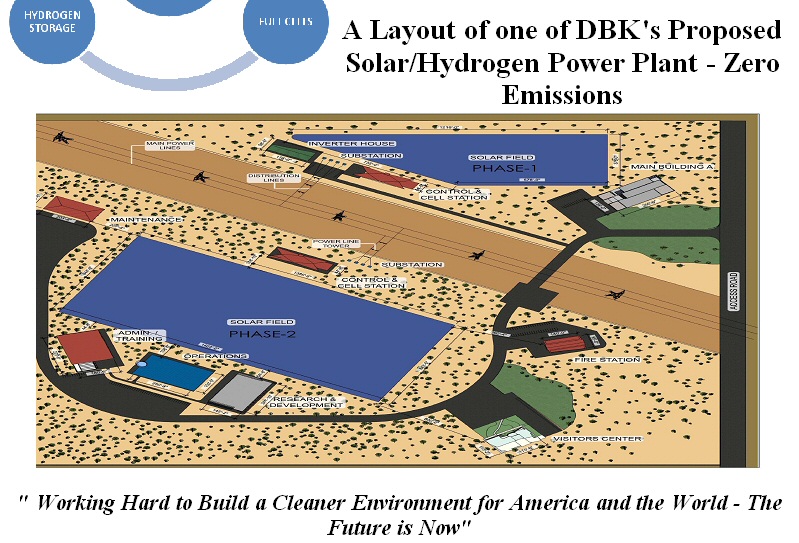
Yup, got to think big! Apparently they plan on expanding
their (nonexistent) solar panel business into a (nonexistent) fuel cell
business. This (painted) fantasy leads off the DBK Solar web site (www.dbksolar.com).
(3/5/08)
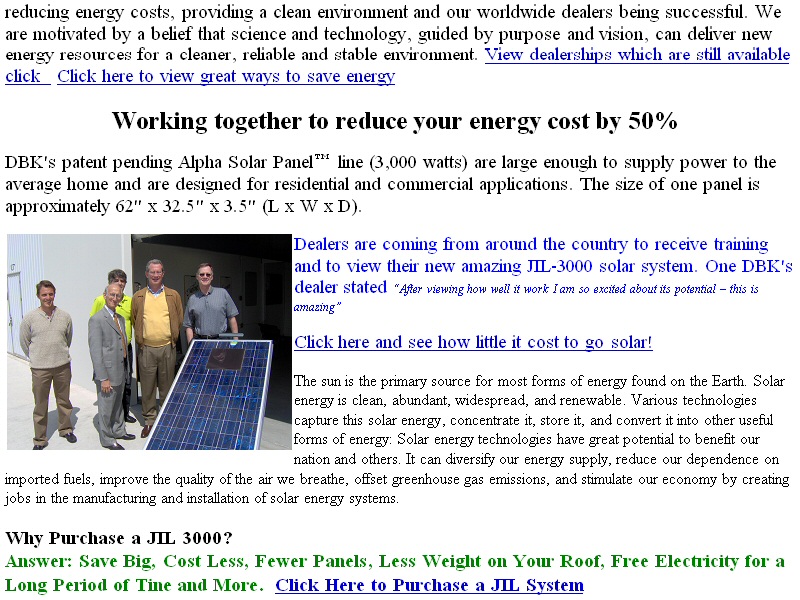
Scammers and scammees (new dealers). This picture
has been online for 1-2 years. (3/5/08)
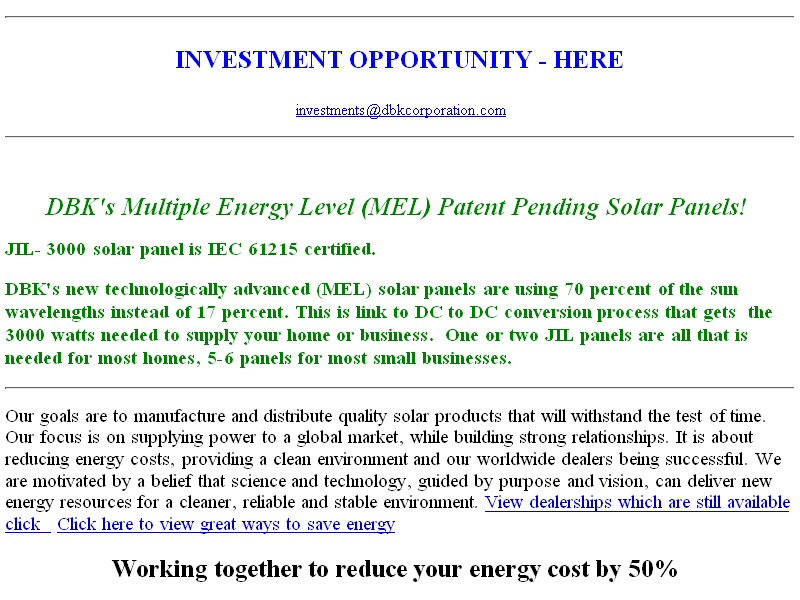
Even if their (supposed) new technology could increase
captured "wavelengths" a miraculous x4 (17% to 70%),
how is this an explanation for their (claimed) x18
increase in power output?
A non-existent panel is IEC 61215 certified? I don't
think so. (3/5/08)

This announcement is a beaut and has generated a lot
of snickers online.
Panels sell for $22,000 each, so a 10,000 panel donation
is a $220 million donation!
Well, at least it's for the kids.(3/5/08)
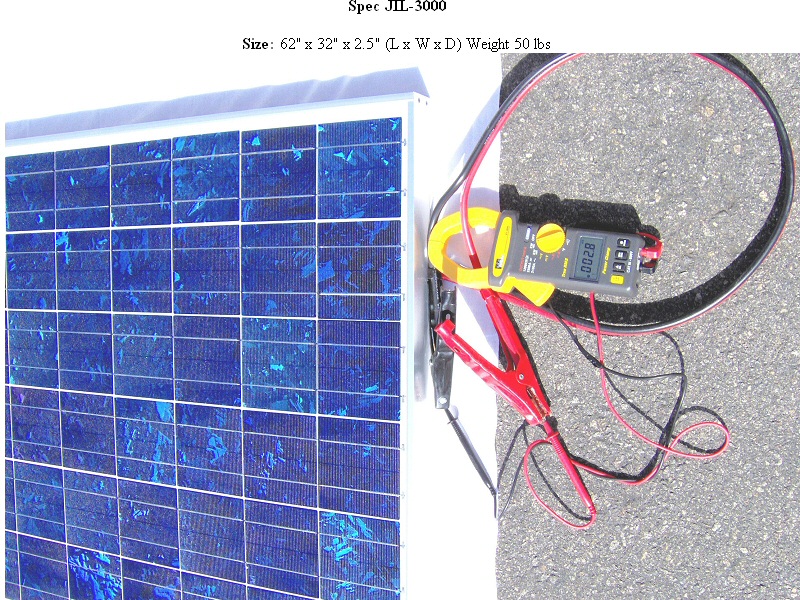
Supposedly a prototype of the DBK 3,000 watt solar
panel. The same picture has been online for 1-2 years.
From its appearance it appears to be a standard crystalline
silicon panel with 72 cells (6 x 12).
Typical output of a 72 cell silicon 5 x 3 ft panel
is about 36V x 5A = 180 watt. (3/5/08)
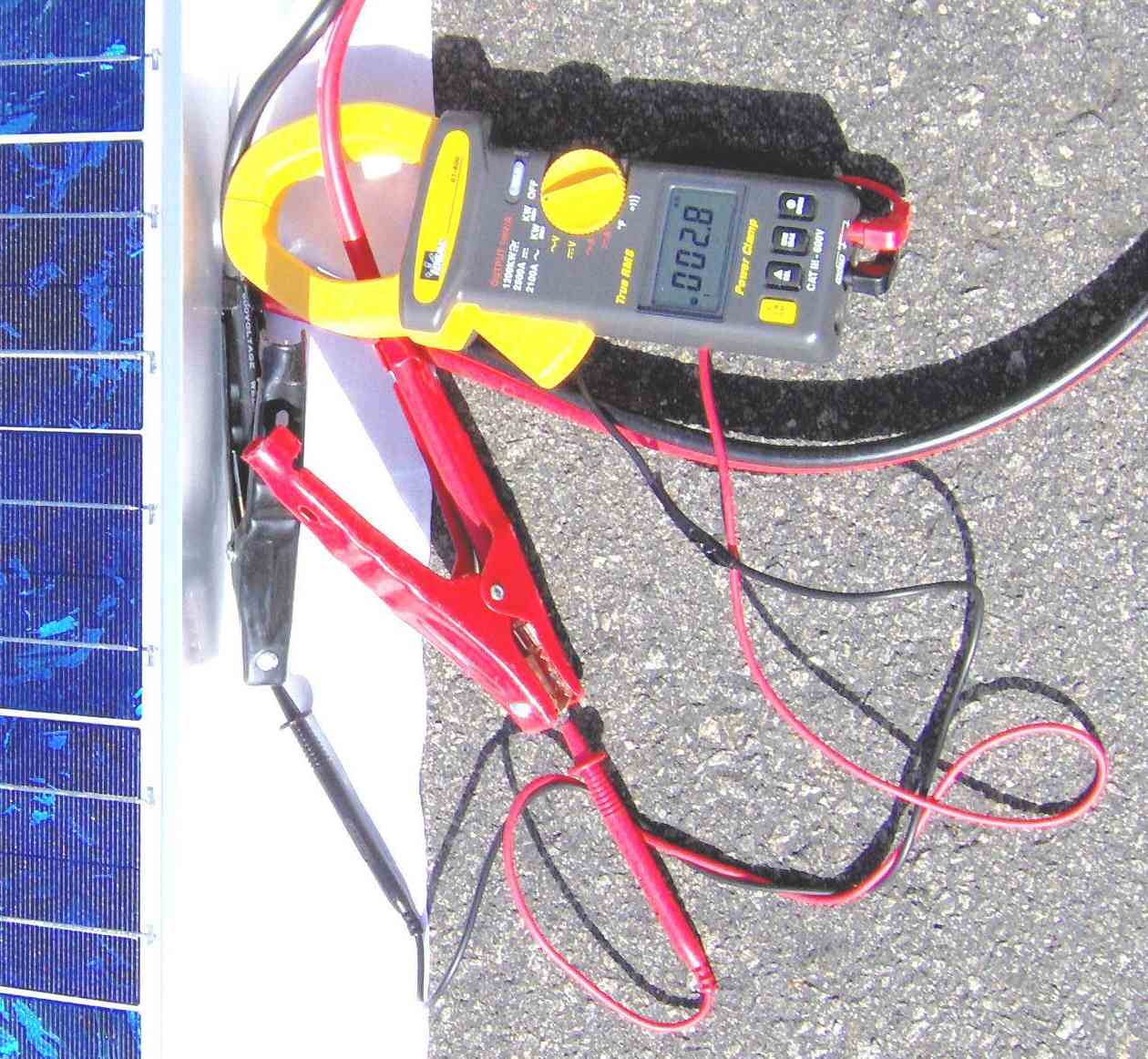
Close up of the power meter above shown connected
to the DBK panel and reading 2.8KW.
A power meter multiplies the voltage (measured by
the red and black leads times the current thru top hole.
Since the red lead of the panel is only connected
to the red lead of the meter, the red current is virtually zero,
so the actual power output of the panel is not 2.8
KW as shown, but 0 KW. (3/5/08)
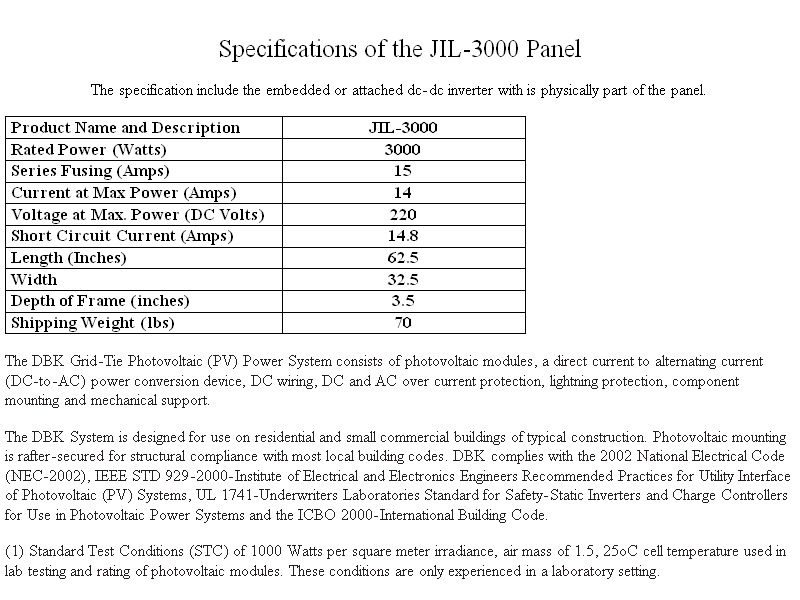
This is the only specification of DBK's 3,000 watt
solar panel.
By 'specing' the panel and inverter combined, the
numbers become a meaningless jumble.
The solar panel is effectively not speced (3/5/08)
Notice footnote (1) above shows solar input power is 1,000 w/m^2 (standard test condition for solar panels). For a panel this size this means the total power in sunlight hitting the panel is [1.3 m^2 x 1,000 w/m^2] = 1,300 watts, but the rated output power is 3,000 watts (higher than the input). This means the efficiency of the panel is greater than 100%! The not so little problem with this is that it is theoretically impossible, yet there is no mention anywhere about this remarkable property of the panel. Why?
Here are my suggestions:
a) Author of the specification is so stupid, he didn't notice, or
b) Author noticed, but didn't think it worthy of comment, or
c) Author noticed, but hoped others wouldn't
SuperSolarIndia --- Another DBK front company (2/16/10)
I found another
front company/site of DBK Solar called SuperSolarIndia. DBK is mentioned
on the site. Their only product (coming real soon) is the JIL-3000 solar
panel. It's close to the spec above, but not exactly the same. The attached
notes say the panel illumination is 1,000 w/m^2, so again Boyd is claiming
a solar panel that operates at near 200% efficiency! Here is a screen
capture from SuperSolarIndia site showing the JIL-3000 panel spec. The
copywrite date on the site is 2008.
http://www.supersolarindia.com
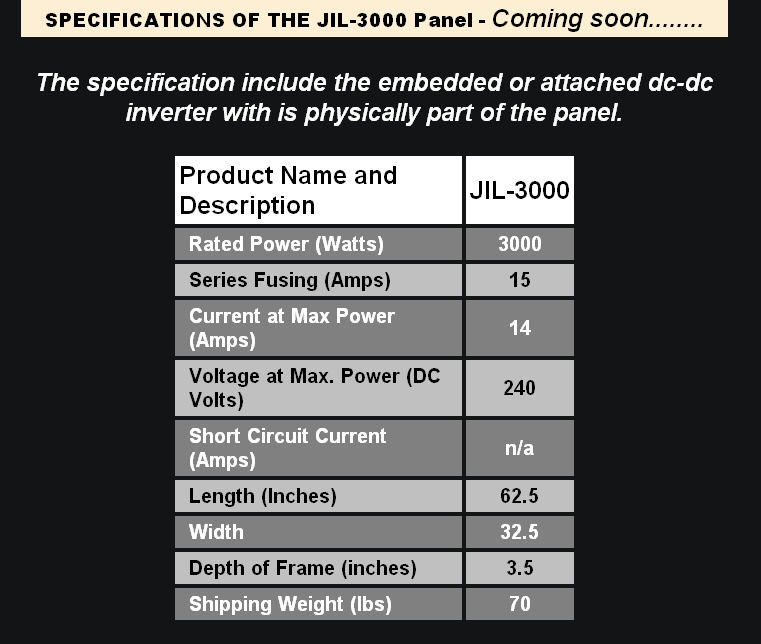
source --- http://www.supersolarindia.com
(screen capture 2/16/2010)
(update 11/19/09) Fusing weirdness
Only recently
did I notice the weirdness in the fusing spec of the JIL-3000 panel above.
A fuse spec on a solar panel is information to the user on how large
a fuse you can use in series with the panel and still protect it. The 16
slides in the link below discuss solar panel fusing. They show a 175 watt
panel with a 15A fuse spec, the GE 200 watt panel (below) has a 15 fuse
spec, and DBK's panel also has a 15A fuse spec (line 3 in table above).
In the link above they use a 10A fuse, centered between 5.5A panel operating current and 15 A fuse spec. The 10A fuse is operated at 55% of its rating (5.5A/10A) with blow time set by overload of 150% (15A/10A). This will give good lifetime and reasonably short blow times. But look at the ratio of the two currents on the DBK panel, the operating current of 14A is almost on top of the 15A fusing current. This is ridiculous. Fuses are not precision devices. The gap is too small. It can't be reliably fused. (I guess Boyd either forgot to adjust the fusing spec when he penciled in 14A operating, or he maybe he just didn't understand about fusing!)
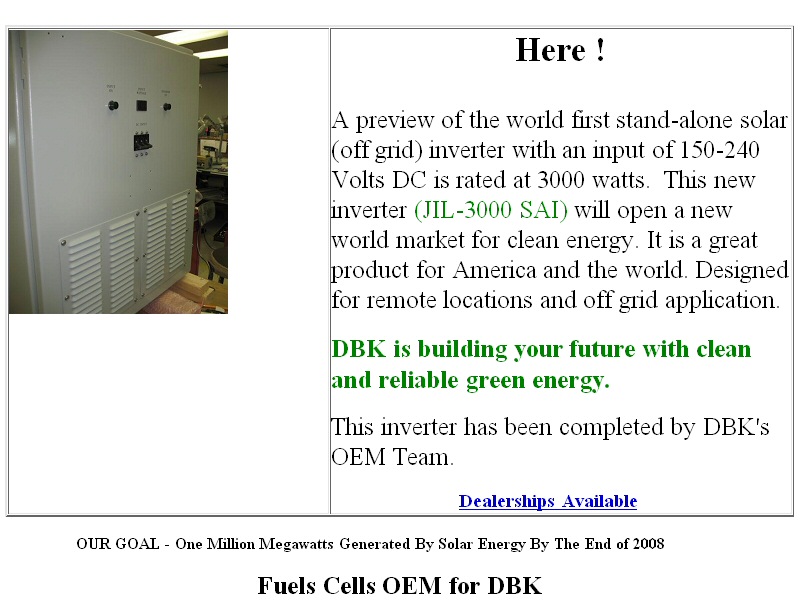
Some inverter! --- This is just a picture of the outside
of a standard cabinet door (3/5/08)
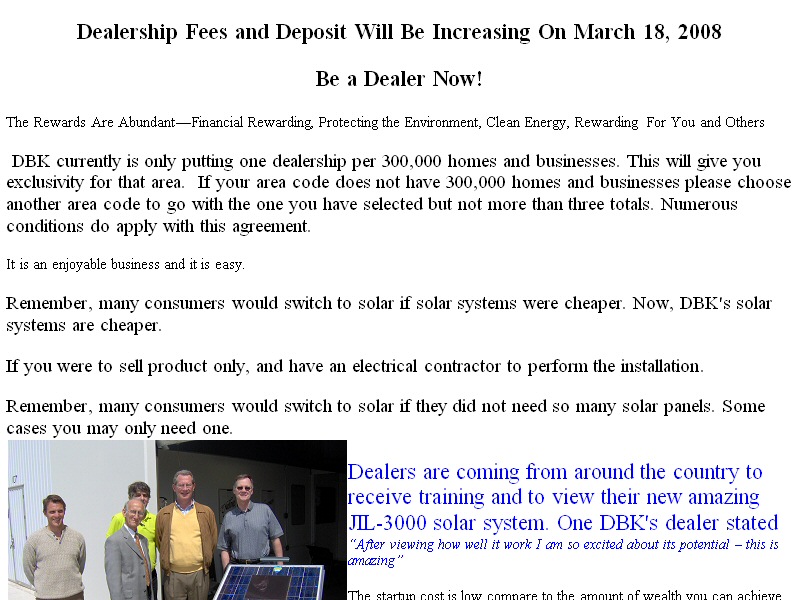
Selling dealerships --- Hurry, costs are to rise in
just two weeks from screen capture date! (3/5/08)
DBK's other sites
DBK has several
other web sites besides solar that together try and give the impression
that it is a large energy company. The potemkin village that they have
build (online) is quite remarkable. Below is a screen capture from the
DBK corporate site --- http://dbkcorporation.com
If you Google DBK Solar Utilities of California or DBK Solar Utilities of Nevada you get only one hit, this site. What do you think is the odds that these companies actually exist?.
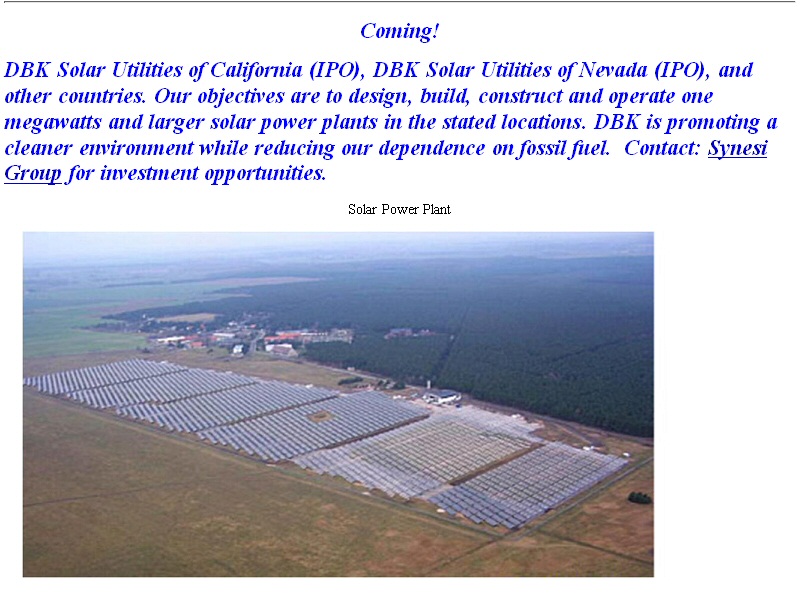
Notice this solar power plant image is uncredited
by DBK and no information is provided as to its location or developer.
What do you think are the odds that DBK had anything
to do it? I'm guessing metaphysical zero.
In 5 min online I located the above image. It is in fact the Rote Jahne Solar Park in Saxony, Germany, and at 6 MW (peak) it is one of the largest solar panel arrays in the world. It's built with about 100,000 60 to 70 watt (60 to 70 V @ 1A), thin film cadmium, 10% efficient, modules made by the USA solar company, 'First Solar', based in Arizona. Surprise, surprise, DBK had nothing whatsoever to do with it!
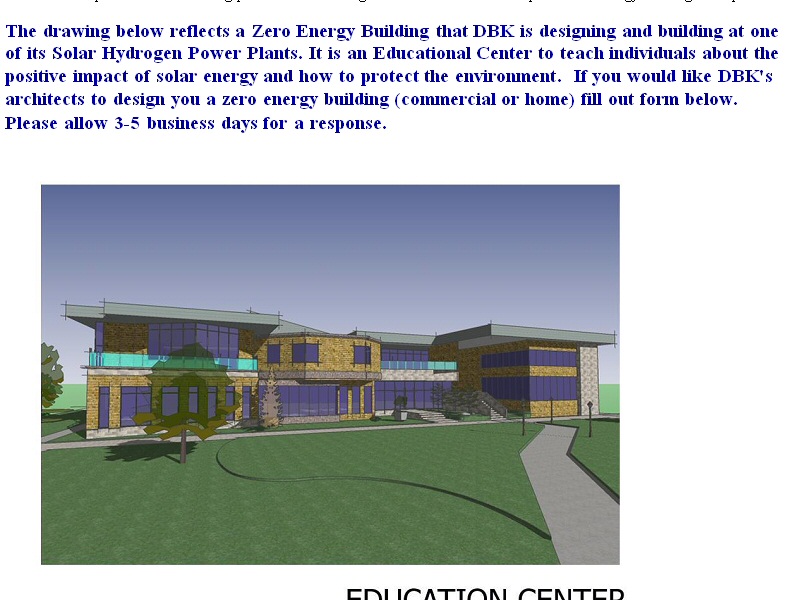
Wow, DBK will design a Zero Energy Building just for
you! I wonder how much up front they want for this?
Competitor solar panel
Here is what
a spec on a real solar panel looks like. Below is a screen capture from
GE 200 watt solar panel, which is about 12% bigger in area than the DBK
3,000 watt panel (GE
GEPVp-200 solar panel spec). (Notice it is speced and tested at 1,000
watt/m^2, which is the standard test value for bright sunlight on the earth's
surface.)
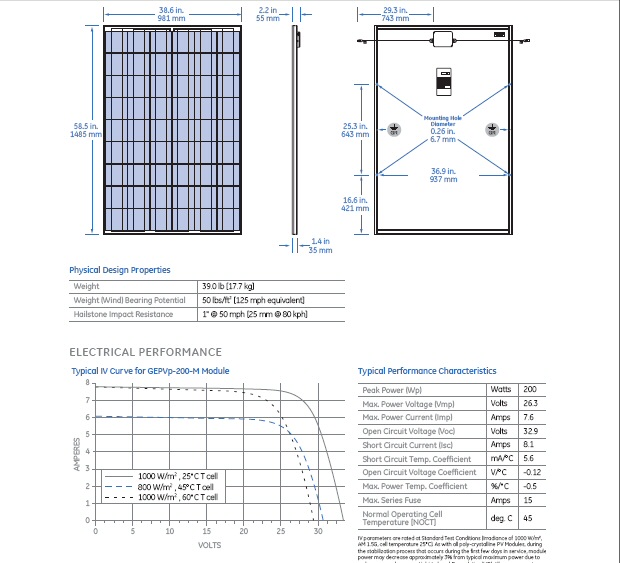
Real solar panel (from GE), 200 watts from a 1.46
m^2 panel @ 1,000 w/m^2, 25C.
Notice, however, that curves show the power out declines
about 30% (to 140 watts)
when the sun dims 20% (800 w/m^2) and the cells warm
up to 45C.
IV curve is approx rectangular, so the power output
can be estimated (on the high side) by multiplying short circuit current
(8.1 A) times open circuit voltage (32.9V) = 266 watt, which is 1.33 times
rated 200 watt power output.
I am attaching Darry Boyd's patent application for his 3,000 watt solar panel with power amplifying technology. Note the correspondence address on the application is the address of DBK Solar, its filing date matches the date DBK 'unveiled' its new panel, and its 3,000 watt rating and power boost factor of 18 matches DBK's marketing claims, so there is little doubt that this discloses the technology underlying DBK's revolutionary solar panel claims. It's also likely that the identification of Darry Boyd as DBK's president by an unhappy DBK dealer is correct.
A patent application is not a patent
Note below
is not a patent, not a provisional patent, it is just a patent application.
While patent applications from companies are virtually all written by patent
attorneys, anyone is free to write an application and submit it directly
to the patent office and some individual inventors do. The patent office
normally sits on applications for about 18 months, and then if you pay
a steep extra fee (currently $300) it makes them public by publishing them
on their web site. The fact that an application is on the patent office
web site does not imply that patent office has reviewed it or has
in any way approved of it. It only means only that the application was
received over 18 months ago and is awaiting review.
The structure on the right marked (110, 115, 135) is the (magic) 'power amplifying' NPN transistor that (supposedly) boosts the current and power out of the panel. From 6.6A to (about) 120 amps (1,320 amps I think is a typo) and from 165 watts to (about) 3,000 watts, both boosted by a factor of 18, which is exactly the boost factor DBK claims in their marketing literature. The three other PN structures (supposedly) capture different parts of the solar spectrum and (somehow) assist in the (theoretically impossible) power amplification.
Footnote
You can find all
US patents (& published patent applications) on the US patent web site,
but to see patents in full (with the figures) takes special software, since
patent page "images" are in an oddball .tif format. So to circumvent that
problem I downloaded Boyd's entire patent application and have attached
it except for two figures, one of which duplicates the cover figure and
the other is a minor, auxiliary figure.
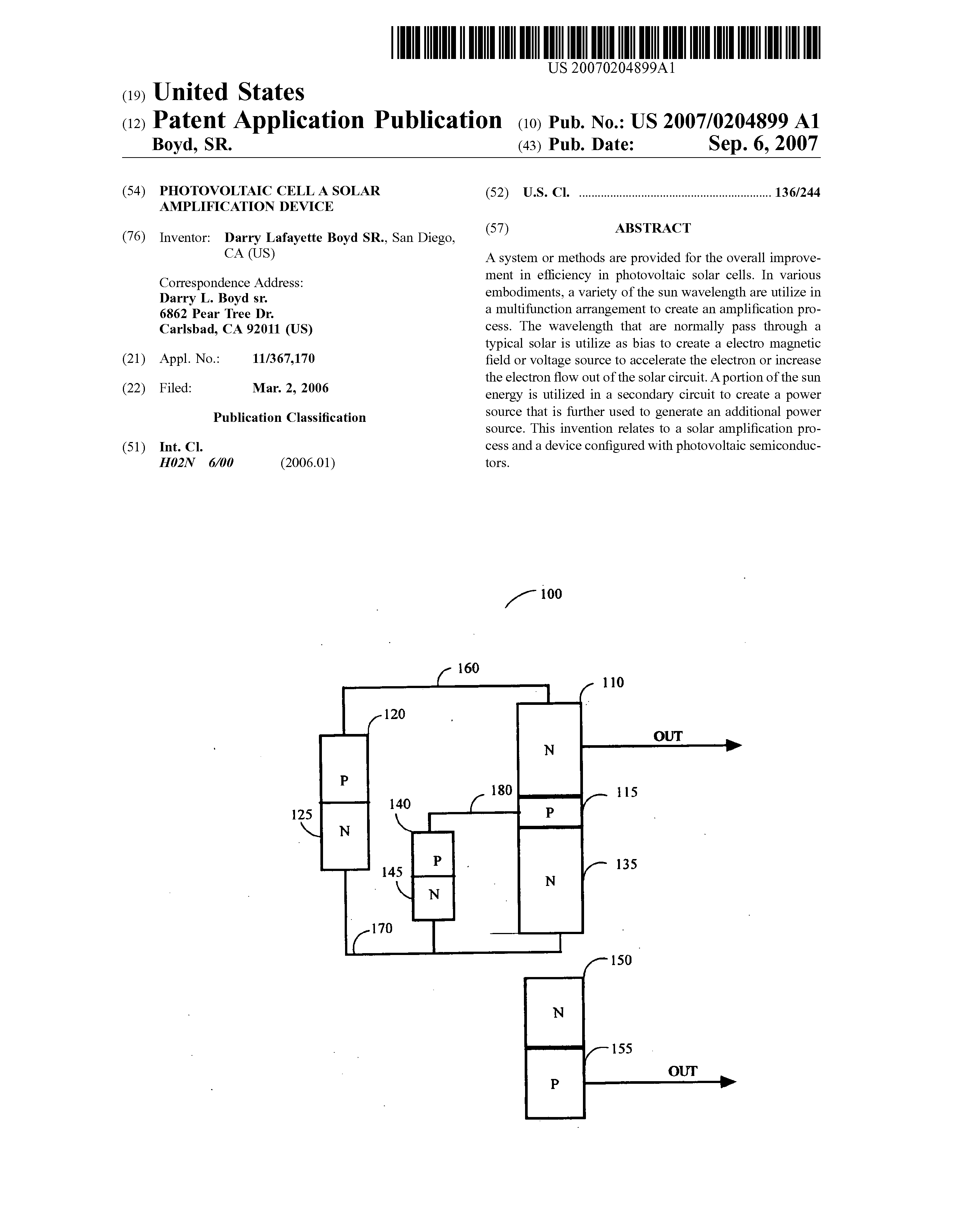
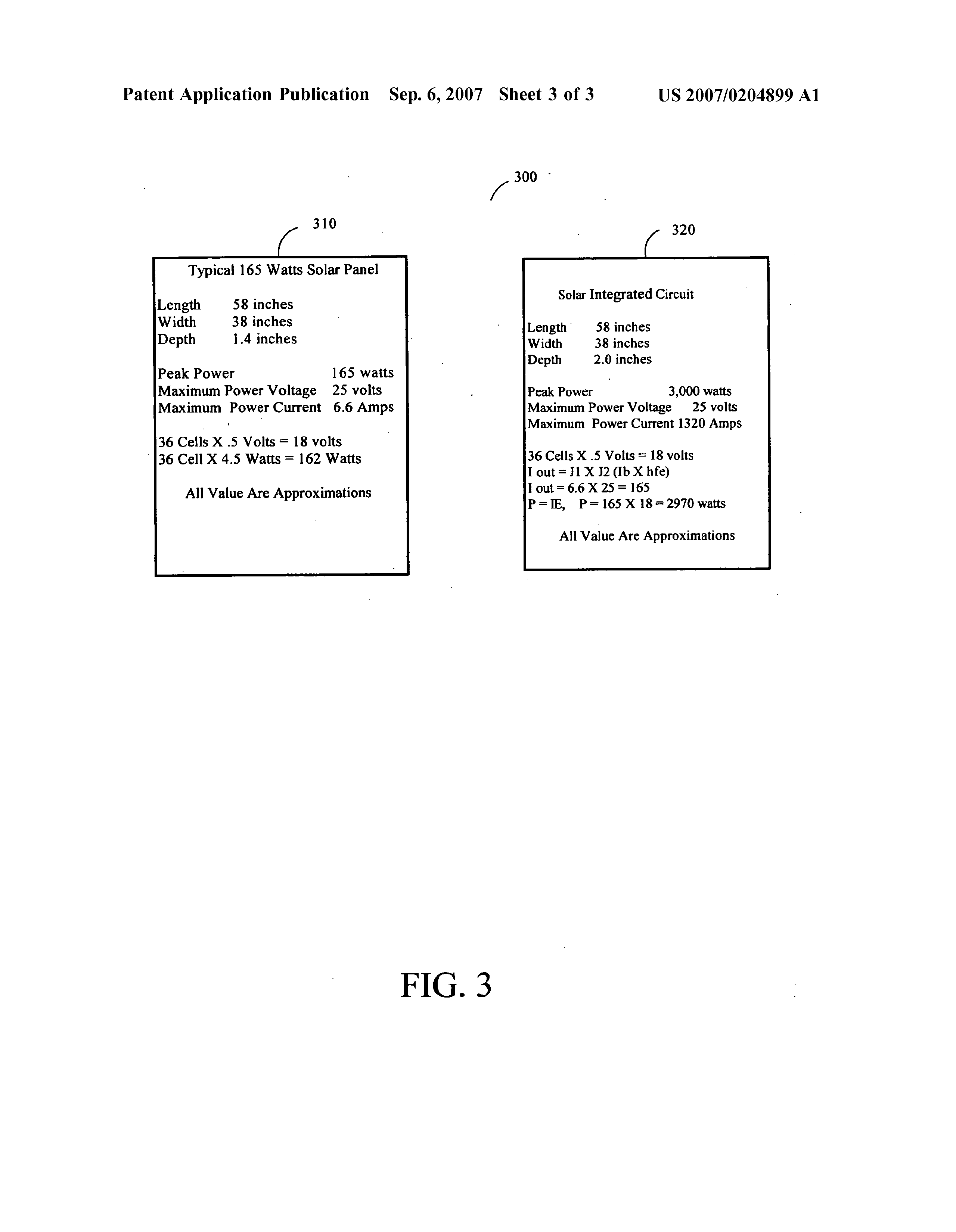
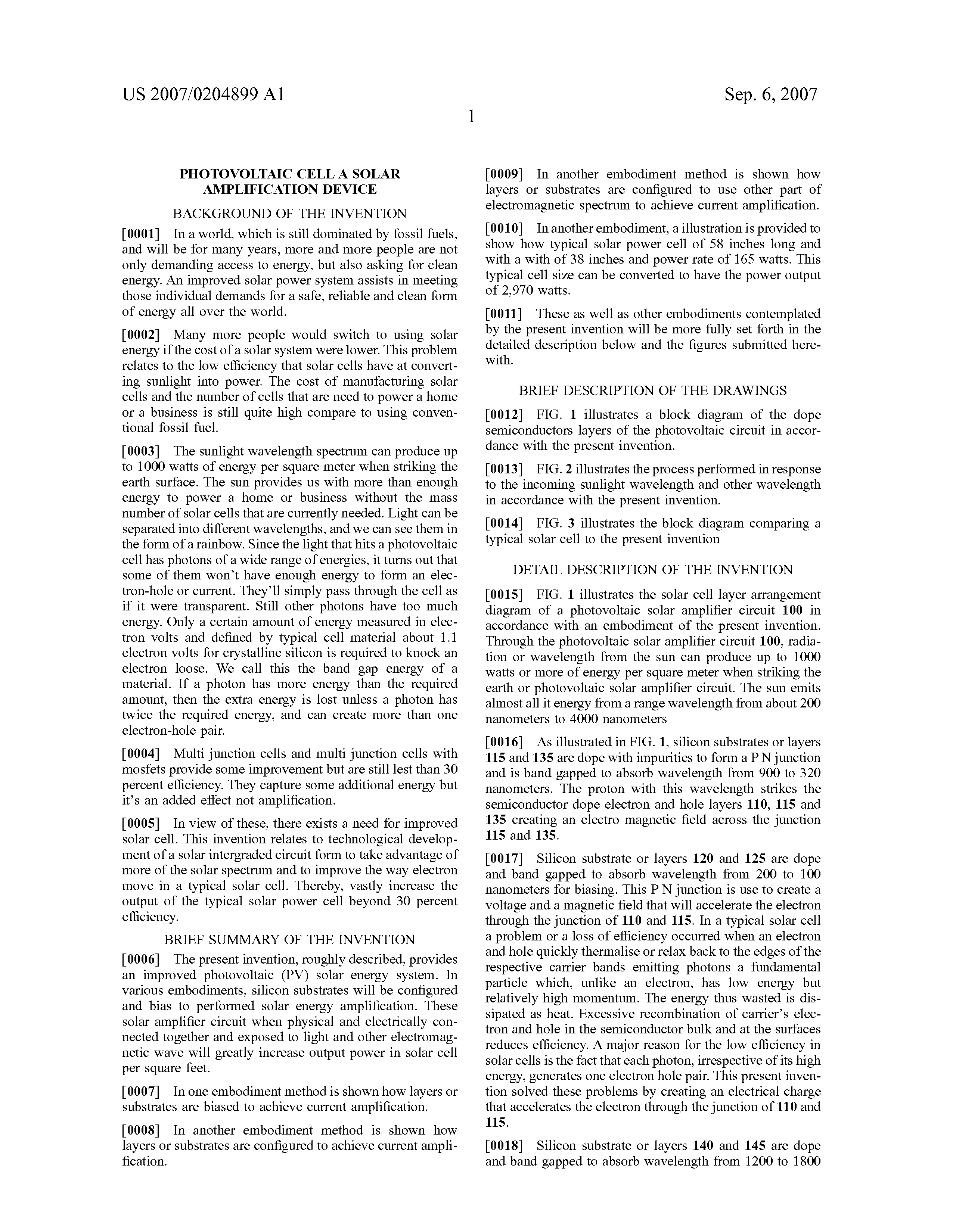
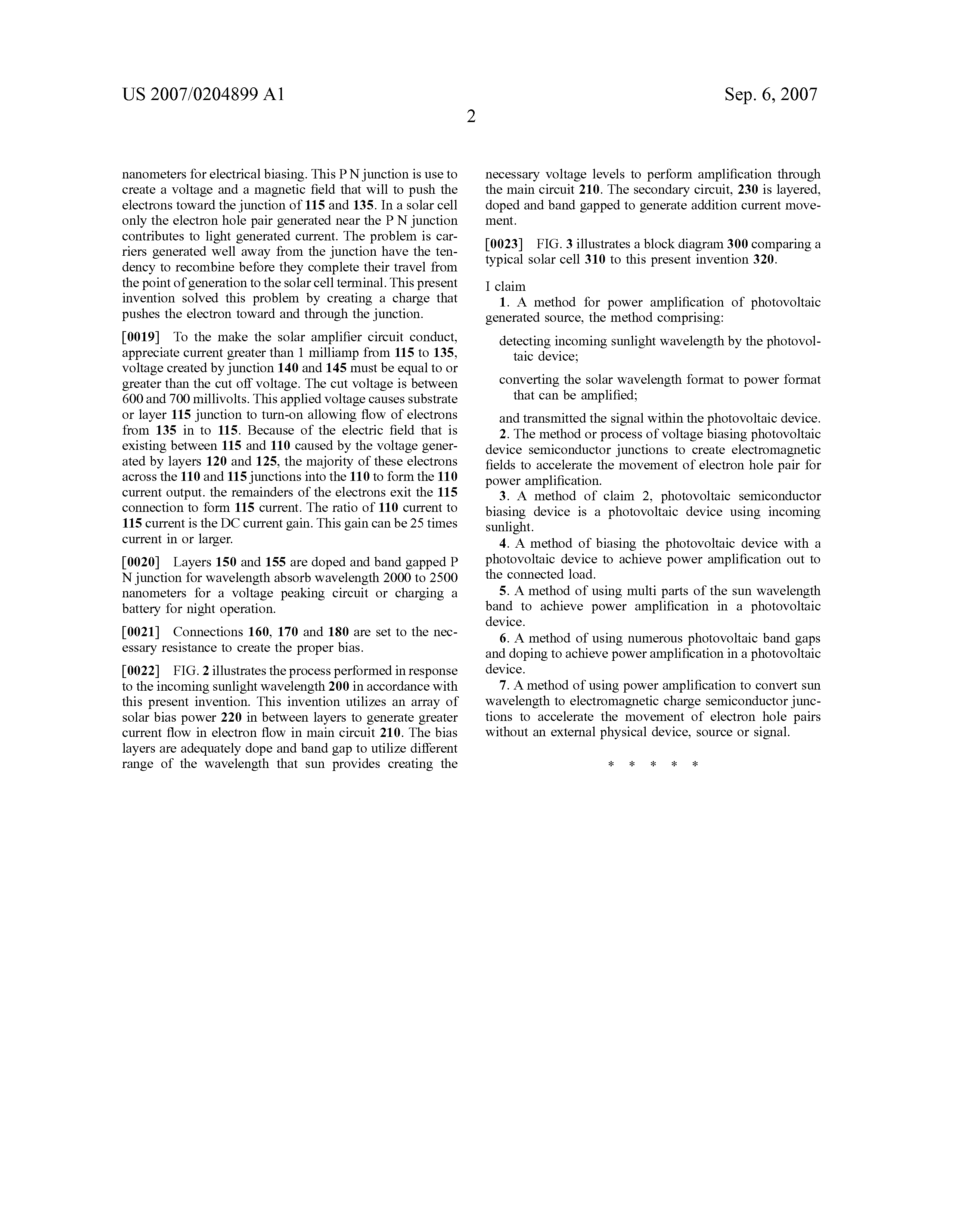
DBK principals
& addresses (3/19/08 update)
Darry L. Boyd,
San Diego CA. (Founder & President) --- In dozens of listing for different
products on powersourcing.com Darry L. Boyd is the contact name for DBK
A 2007 blog posting identifies him as president of DBK Solar, 300 Carlsbad
Village Dr. #108A, Carlsbad, California 92008. An alternate address
for Boyd --- Darry Boyd • P. O. Box 32761 • Palm Beach Gardens, Florida
33410 • (877) 325-7693. Another alternate address for Boyd (from
his 2004 patent filing) is Darry L. Boyd, P.O. Box 261358, San Diego CA,
92196. Possible residence --- DBK Corporation, 6809 Corintia Street, Carlsbad,
CA 92009. (DBK Solar locations are given as Carlsbad, CA and Palm Beach
Gardens, FL). Darry L. Boyd may also be know as Darry K. Boyd (see below).
The picture of Boyd below was found on the (2006) web site of a Malaysian DBK Solar dealer.
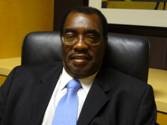 .
.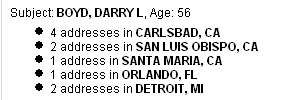
Darry Boyd, Founder and President of DBK Corp
(from www.parasolar.net)
Deborah Valentino, Vice President Marketing, DBK Corporation, Carlsbad CA --- (from a signature on Feb 20, 2008 letter to Senate Majority Leader, Harry Reid, from American Council on Renewable Energy). A powersourcing.com lists the DBK contact as, D. Valentino, 300 Carlsbad Village Dr. #108A, Carlsbad, California 92008, (877) 325-7693, (760) 918-6643. In Dec 2006 a blogger posted this email he received from Deborah Valentino of DBK
"As for the rumors I'm sorry to say I know of the website you have mention and they are an oil company who really doesn't want our customers to use solar. Our solar system does what we say it does. The system has been third party tested and is approved by the IEC. We are having a demonstration of the system for Dealers within the next few weeks and we may have another one for purchasers if we get enough participates, if you are interested in viewing this demonstration I will put you on the list and please come and view the JIL-3000 here in San Diego, CA." (Dec 2006 blog posting of an email from Deborah Valentino of DBK's San Diego office)Ray G. Files, Carlsbad, CA --- In Feb 2004 Files and Boyd jointly filed a short, self written (vague as hell) patent application on a topic unrelated to solar energy (cell phones). In Sept 2004 a more detailed continuation of the Feb 2004 filing.was made, the continuation apparently written by a patent lawyer. (Note Files' address city of Carlsbad CA is the location of DBK Solar.)
Patent
application 20050174992 A1 self written patent filing
by Darry Boyd and Ray Files
(Feb 9, 2004)
Young Yang, Ph.D., DBK Corporation, 300 Carlsbad Village Dr. Suite 108A #327, Carlsbad, CA 92008, 877-325-7693, 760-918-6643 (fax) (from a 2006 DBK email posted to a blog)
(3/28/08) The
web site of my local DBK Solar dealer (Solar Edison LLC, Salisbury MA,
www.solaredisonllc.com) appears to have recently gone down. According to
a local newspaper story (below) as of Feb 20, 2008 they were expanding,
though by that time DBK Solar no longer appeared in their product list.
http://www.seacoastonline.com/apps/pbcs.dll/article?AID=/20080220/NEWS/80220006/-1/BIZ&sfad=1
(3/30/08) It's not just a solar scam --- Here is a fuel cell blog posting from a guy who says he is a "dealer for www.dbkengineering.com" and "I control DBK distribution for the 936 area code." He is trying to raise 13 million dollars from investors to build a 10 meg DBK solar/hydro plant in Texas. Yikes!
http://www.fuelcells.org/dc/dcboard.php?az=show_mesg&forum=7&topic_id=176&mesg_id=403&page=
(4/3/08) A lot stuff from DBK's site also appears on a fairly large site called ParaSolar.net, which is based in Malaysia. Parasolar boasts of planning to invest billions of dollars in DBK technology (!!) by building 50-200 mw solar installations in Asia by 2010! For perspective the 6 mw German solar plant (included in this essay) is currently one of the largest in the world.
http://parasolar.net/innovators.html
My take is either the Malaysian, Dato’ Zainal Abu Zarin, Founder and President of ParaSolar, bought the DBK story hook, line and sinker, or Boyd found an associate. Interestingly the Parasolar site includes a picture of Darry Boyd, labeling him "Founder and President of DBK Corporation Inc", which I put into his bio above.
(4/4/08) A
patent search reveals that Darry L. Boyd has been granted one patent (D384,298,
"Load Gauge Block", filed Nov 2, 1995). Note the prefix 'D', this is not
a 'real' patent. Technically it's a 'design patent'. It consists only of
a sketch of an "ornamental" object and has no text. It appears that Boyd
filed this himself and on it lists his residence as 1314 Oceanaire, San
Luis Obispo, CA. 93405
--------------------------------------------------------------------------------------------------------
Another piece of
the puzzle drops into place (4/3/08)
In 2007 DBK
began making the claim that their 3,000 watt solar panels were "IEC 61215
approved". This always seemed to me like a strange/oddball claim, but now
it makes some sense.
I recently came across a company in the UK named, DBK Technitherm Ltd, that sells solar panels that are "IEC 61215 Certified". These appear to be the real thing, solar panels that have been tested and approved by the European testing agency IEC. Lists of approved products are always available from testing agencies, so this means that DBK Solar of Carlsbad CA can open up an IEC listing and show customers that there is indeed an IEC approved DBK solar panel! How is this possible?
It's possible because these 'DBK' solar panels are only 20 to 80 watt. They are made in the UK by a company that is part of the "DBK Group" of companies based in Germany, founded in 1946 and totally unrelated to DBK Solar, Carlsbad CA. Boyd is trading on the similar name of a legitimate UK/German solar panel manufacturer.
http://www.uk-solarpanels.co.uk/dbk801.html
http://www.uk-solarpanels.co.uk/
Early warning of
DBK fraud (4/5/08)
Articles on
DBK in early 2006 in the Lassen County News brought this May 23, 2006 letter
to the editor of Lassen County News (I think) warning about DBK solar technology
from Scott Forest in Palo Alto (see below). He says "DBK panel is impossible"
and "The company DBK Solar is a fraudulent operation." Yup!
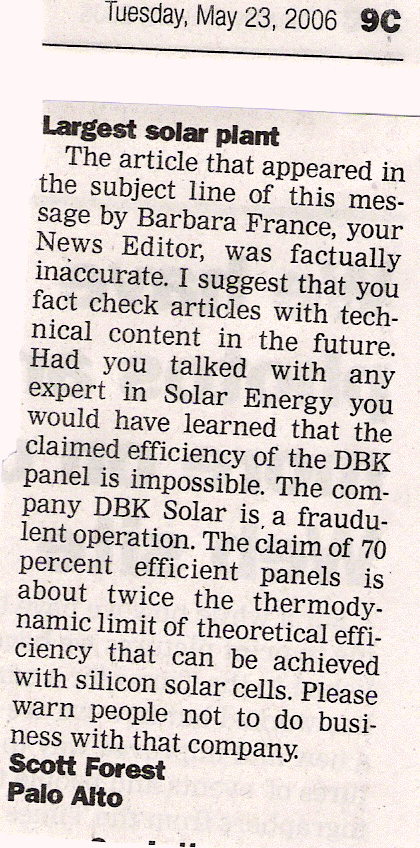
The link below to Mar 2006 postings on 'Energy Portal' on DBK's 3,000 watt solar panel show that several knowledgeable posters more than two years ago recognized that DBK's 3,000 watt claim was absurd and strongly suspected a scam.
http://energy.edu.pl/oil-1475.html
Here's a link to dozens of blog posting from summer 2006 warning of DBK Solar fraud. The page is titled: "This Solar Panel company (DBK Solar) needs to be investigated"
http://www.peakoil.com/fortopic23144.html
DBK Solar address
One poster in 2006 to the Energy Portal blog added:
"Yea, the
company (DBK Solar) is right up the road from me. It happens to be a UPS
store mailbox."
I checked and poster is correct. Below is a screen caputure from UPS site showing the address of its UPS store in Carlsbad AZ, which is 300 Carlsbad Village Dr. #108A, Carlsbad, California 92008. This matches exactly the address of DBK Solar and DBK engineering!
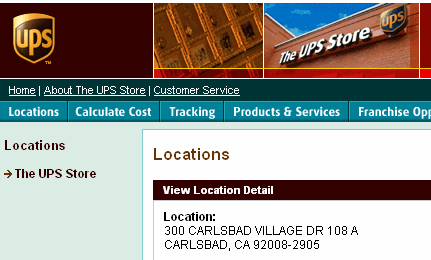
Address of DBK Solar & DBK Engineering is just
a post office box at this UPS Store in Carlsbad CA
DBK ENGINEERING general contractor license info (4/5/08)
Someone
on solar
scam web site dug out link to CA general contractor license info (DBK
License Number: 843836). It has two interesting pieces of information on
DBK ENGINEERING & CONSTRUCTION, 300 CARLSBAD VILLAGE DR #108A, CARLSBAD,
CA 92008.
* DBK Engineering
certifies that it has no employees
* Solely owned
by Darry Lafayette Boyd
In other words DBK Engineering is a one man (zero man?) company and that man is Darry Lafayette Boyd. Here is the link to the CA general contractor license info:
http://www2.cslb.ca.gov/General-Information/interactive-tools/check-a-license/License+Detail.asp
==========================================================
The P2Solar web site now lists Raj Gurm as CEO with no mention of Darry Boyd. Raj Gurm bio on the site says he "comes from a royal family in the Punjab region" emigrating to Canada when he was 12 years old. And get this, the 1/7/09 business announcement says, "Natco is currently in negotiations with Indian officials regarding Solar Hybrid Power Plants in the State of Punjab". The plants are to be built by P2Solar. Checking the www.P2Solar.com site on 1/10/09 I find the India project is not there, just the forever delayed 200 MW Lassen County solar plant (being built by 'our partner' Lassen Energy).
However, I did find on the P2Solar site a new picture of an unidentified solar panel with three unknown guys (p2team is name of picture file) standing next to it, dated Aug 28, 2008. This is just two weeks after the announcement of the new panel being readied for Natco testing, so perhaps this unidentified solar panel is the new miracle panel that Natco says works just swell?? It's a good bet that CEO Gurm is the guy on the left. He looks Indian and from his bio Gurm is probably in his late 40's.
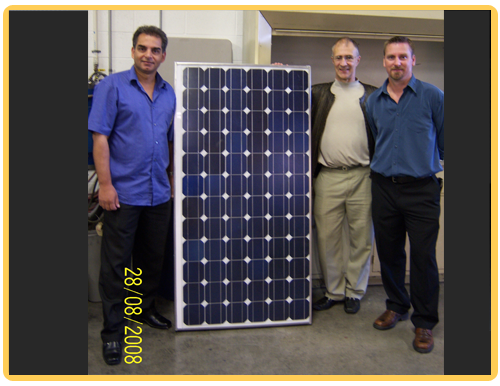
New P2Solar/Lassen Energy/DBK Solar miracle solar
panel? --- source www.p2solar.com (1/10/09)
no one in photo identified on p2solar site, but
Natco CEO Raj Gurm is left and Natco spokesman Hans
Edblad is right.
Yup, above left is Natco International CEO Gurm. Below is a screen capture from a British Columbia TV video about Britsh Columbia company PTV (Photo violation technology), which identifies Gurm.
By the way I found out that Gurm's technical background is biology and (to some extent) chemistry. According Gurn's bio in SEC filings his degree is a BS in biology in 1983 from Univ of British Colombia. At Natco for a few years he ran a tiny manufacturing business (one man did all the manufacturing!) making jewelry cleaning chemicals and a tire sealant. This business that was never profitable and has been closed.
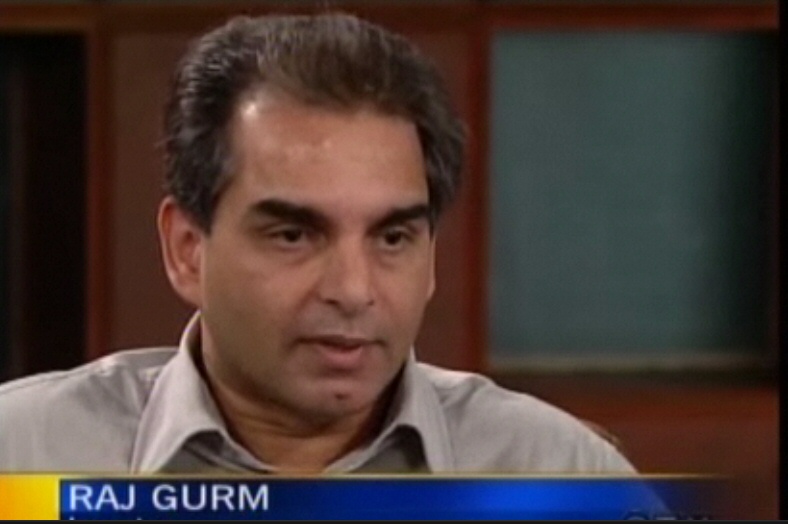
screen capture from a British Columbia TV show ( Nov
7, 2008), linked in a letter from PVT CEO
(Gurm & Natco are fighting with PVT about 1.5M
that Natco claims it loaned PVT
and Natco wants the money returned)
Update (10/10/09)
India and phony Boyd solar panel share equal
billing on P2Solar Web site
Here is a
screen capture from P2Solar web site. This confirms that the solar panel
above is supposed to be the miracle solar panel. In the upper right photo
(below) we see the miracle solar panel again, but this time with the techy
label: 'Hybrid solar panel prototype version 2'. It's being 'demonstrated'
(to whom, of course, is not mentioned) tilted toward the sun with loads
attached, and standing next to it appears to be Hans Edblad. Photo lower
right is more misdirection: a vaguely labelled photo of a solar array trying
to give the rubes the impression P2Solar had something to do with this.
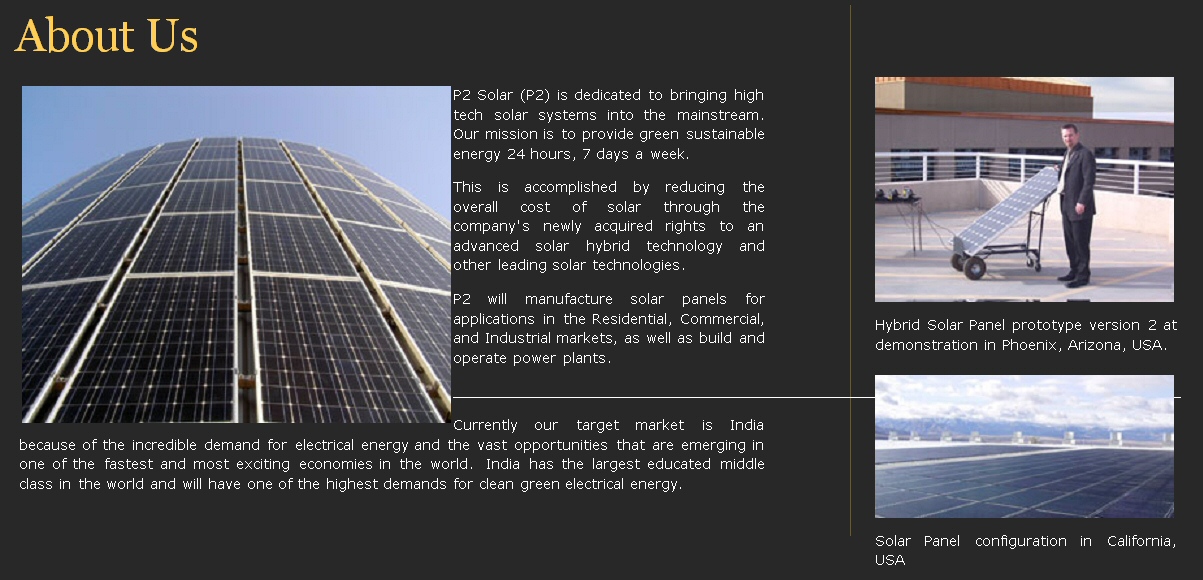
screen capture from http://www.p2solar.com on 10/10/09
"P2 Solar, Inc. is dedicated to building Solar Power Stations, currently focusing its efforts throughout India. It is also involved in the manufacturingof an advanced Solar Panel and other solar technologies." (from Sept 09 P2Solar business announcement.)
Update (1/16/09)
A micro-stock
house (Quality Stocks) had an 9 minute audio interview with Natco International
about their solar technology (12/5/2008). Natco spokeman in inteview was
Hans Edblad. He mentioned they will be looking for dealers!!
http://www.qualitystocks.net/videocharts.php?chartvid_id=129
Update (12/26/08)
Here are Natco's
SEC filings of recent months concerning the Lassen 3,000 watt solar panel
Dec 04, 2008 -- Announces Lassen Hybrid Solar Panel Is Independently
Verified!
Oct 22, 2008 -- NATCO International, Inc. Announces Panel Test
Update
Aug 15, 2008 -- Lassen Energy Inc. Successfully Completes Panels
in Preparation for Testing
In Aug the panel was built and ready for test. In Oct testing was in progress. And come Dec, what do you know, who could have guessed, surprise surprise, the panel passed all its tests (outputting 2,700 watts av).
Tests were conducted on one panel by an unnamed prof of engineering of an unnamed institution at unknown test conditions, and the report was not released, but rest assured it's in Natco's files. I emailed CEO Gurm asking for a copy of the report and got no reply.
In last eight months the business conditions between Natco and Lassen have changed too. You know that reverse merger that Natco and Lassen announced. Well, forget that shit.
Nov 26, 2008 -- NATCO International, Inc. and Lassen Energy,
Inc. Sign Material Definitive
Agreements
Dec 09, 2008 -- Natco International Inc. Shareholder Update
Now they have agreed to swap a few shares and (get this) Natco is paying up front one million dollars to get the rights to manuf, and sell the panel in only Canada, India, and the state of Hawaii. From Nov 26, 2008 Natco business release:
"Simultaneously with the execution of the Share Transfer Agreement, NATCO entered into a License Agreement with Lassen and its affiliates regarding the use of certain intellectual property owned by Lassen and affiliates necessary for the manufacturing, distribution and sale of Hybrid Solar Panels throughout the Nations of India and Canada, and the State of Hawaii.On paper this looks like a con by Boyd of Gurm for one million. Or has Gurm just put up a million to get in on a good thing, extending the DBK/Lassen solar panel scam into India and agreeing with Boyd to split the profits?The consideration to be paid by NATCO to Lassen for the Licenses is an initial fee of US $1,000,000 together with a 2% royalty on gross revenues received by NATCO from future sales of Hybrid Solar Panels."
Update (8/15/08)
Natco International,
which is being taken over by Boyd's Lassen Energy, changed its Over the
Counter symbol from ncii to nciie for a week or so, and then back to ncii
again. Weird. I notice that most of the price history of the stock on the
Over the Counter charts seems to have been cleared by this maneuver, so
I'm betting that is why this swap was done.
Here is the latest business announcements from Natco.
Lassen Energy
Inc. Successfully Completes Panels in Preparation for Testing (8/15/08)
http://www.centredaily.com/business/technology/story/779423.html
The announcement says test panels are built and test "results will be forth coming" Surprise, surprise, no picture. And no info on what size panels or how many were built, who built them or where they were built, what was the cost, who will do the testing, and no date given as to when the results will be forth coming. Quite the announcement.
I know as a power engineer that if the sun is shining a quick test of the power potential of a solar panel can be obtained in minutes using nothing more than standard digital meter. Do you suppose that maybe, just maybe, the next announcement (in a few weeks or months) will be that the test criteria have been met. I'd take that bet.
Lassen Energy
Inc. Secures Funds to Build Hybrid Solar Panel Test Models (June 26, 2008)
http://app.quotemedia.com/quotetools/newsStory.go?storyId=9773771&topic=NCIIE&symbology=null&cp=off
What, the panels they need to demonstrate they can get more power out than the sun puts in, don't exist? Surprise, surprise.... But they're coming real soon.... (Maybe Boyd forget that all he needed to do was borrow a 3,000 panel for the test from his company DBK Solar, which claims to have been making deliveries for months.)
Update (4/23/08)
A second business
announcement about the pending Natco & Lassen merger was released 4/21/08
by Natco's PR/investor relations firm with merger details provided next
day in a Natco SEC 8-K filing. Here are the links:
NATCO Executes a Share Exchange Agreement with Lassen
Energy Inc. (4/21/2008)
http://news.moneycentral.msn.com/provider/providerarticle.aspx?feed=BW&date=20080421&id=8513494
The key information
provided is that Darry Boyd is (essentially) taking over Natco
--- Darry Boyd will become CEO
--- Darry Boyd will own 92.5% of the shares of the merged company
--- Natco will change name to P2Solar (& OTC symbol change is planned
too)
The 4/21/08 'Share Exchange' business release speaks of a 90 day period where shares are held in escrow until Lassen (meaning Boyd) can verify its solar technology, saying that Natco is allowed to hire an outside expert.
A more detailed look
However, a
look at the Natco 4/22/08 SEC 8-K filing puts a very different spin on
this (so called) verification of technology.
-- Natco is allowed to hire an outside expert, but is not required to. (So apparently the only one that need be satisfied is Raj Gurm of Natco, and what does he know about solar panels?)
-- The (so-called) verification consist in showing that Lassen's 3,000 watt solar panel meets its specs, which are detailed in the 8-K filing. However, a look at this (so-called) specification show it is nothing more than DBK Solar's 3,000 watt panel 'specification', which of course is not an engineering specification at all, just a meaningless jumble of numbers. So in reality the merger 'technology verification' is a joke.
Bottom line
So what's
the point of this merger? Mergers of SEC registered companies are
widely publicized. The buzz of a merger and claims of exciting new technology
reaching a wide new audience, like investors that follow microcap stocks,
is bound to attract attention to Natco's stock (OTC symbol: ncii). In fact
it has more than doubled since the first Feb merger announcement. I'm sure
someone as creative as Darry Boyd can figure out how to make money from
this!
========================================================================
Lassen Energy, P2Solar, & Darry Boyd (4/4/08)
(update 12/26/08)
In Dec 4,
2008 business release by Natco we find that the name of the CEO of Lassen
Energy has (surprise, surprise!) changed from Darry K. Boyd ==> Darry
L. Boyd. Below is an excerpt from the Natco Dec 4, 08 release:
"The Lassen Hybrid Solar Panel™ is based on inventions and innovations of Darry L Boyd who is Lassen Energy Inc.’s CEO. Like all Photovoltaic systems it relies on activating electrons to produce direct current (DC). When this technology is combined with other panel components, the cost of the panel per Watt is decreased and the Watt production is increased."----------------------------
On Feb 25, 2008 Lassen Energy (Doing Business As -- P2Solar) signed a binding agreement to be sold to NATCO Intl Inc., Surrey, 204, 13569 - 76 Avenue, British Columbia V3W 2W3) as reported by Reuters.com (below)
"Mr. Raj Gurm, President of NATCO, announced that on February 22nd, 2008, the Company entered into a Binding Letter of Agreement (the "Letter Agreement") with Lassen Energy, Inc. ("Lassen"), a company incorporated in the State of California, and all of its shareholders for the acquisition of all the issued and outstanding shares of Lassen, subject to the terms and conditions of the Letter Agreement."http://www.reuters.com/article/pressRelease/idUS220186+25-Feb-2008+BW20080225
Here's Lassen Energy as described in the Reuters 2/25/08 press release above
"Lassen has patented a revolutionary solar power generating system that incorporates advanced solar and fuel cell technologies to produce energy at a superior performance efficiency level.Sure sound like our Darry L. Boyd of DBK Solar. This Reuters story comes fromThe principal of Lassen is Darry K. Boyd.
Darry K. Boyd, BS in electronic engineering and graduate studies in physics, the Chairman and CEO of Lassen, is a general engineering contractor with a Class A license, and is a specialist in constructing power plants and manufacturing. He has 30 years of experience in the construction of many power plants and manufacturing projects."
Capital Group Communications, Inc.
(San Francisco Bay area)
Investor Relations
Mark Bernhard, VP Corporate Communications
Office: 415-332-7200
Fax: 415-332-7201
www.capitalgc.com
Capital Group Communications is a PR firm that represents clients like DirecTV and (interestingly) P2Solar. P2Solar is just a site name for 'Lassen Energy Inc'. Here's an excerpt from the P2Solar/Lassen site describing their management.
"Darry Boyd, President / CEOSure sound like our Darry L. Boyd of DBK Solar. And what do you know, the telephone of P2Solar (877) 325-7693 is the same as Darry L. Boyd lists for his Palm Beach Gardens, Florida address!An accomplished scientist and businessman, Boyd uses his knowledge of engineering and physics to foster technological progress,while his executive acumen ensures market viability for the technologies he backs. He is currently working with an international team of talented professionals to bring new solar and hydrogen technology to the market and, in turn, the masses." (www.p2solar.com) (4/4/08)
Here's an image from the P2Solar site called the P2Team. Wow, this is familiar! The same picture is on the DBK Solar site where these guys are described (probably accurately) as DBK Solar dealers at training!
http://www.p2solar.com/index.php?option=com_content&task=view&id=5&Itemid=6
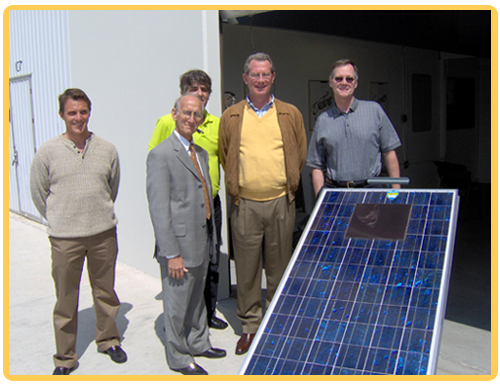
Lassen Energy Team (www.P2Solar.com)
"Lassen Energy Inc. is dedicated to bringing high tech solar and hydrogen systems into the mainstream. Our mission is to provide green sustainable energy 24 hours 7 days a week. This will be accomplished by reducing the overall cost of solar and hydrogen energy through our new technology. Lassen Energy will be manufacturing and building high tech solar panels and hydrogen fuel cells at a record low cost of a dollar per watt. Lassen Energy will also incorporate these high tech systems into our power plants, commercial businesses and residential applications worldwide" (http://www.p2solar.com) (4/4/08)Here's P2Solar/Lassen Engineering describing their solar panels. Sound familiar? Yup, same technology claims as DBK Solar.
"In a typical JIL Solar Panel there are two parts. One part A which we called the cornerstone, which is multi-junctions multi-layers device. Part B which we call the legacy has previous storage energy in it. Part A and B is tied together in a photosynthesis arrangement to release 3000 watts of energy." (http://www.p2solar.com, 4/4/08)Here's the business address of 'Lassen Energy' screen captured from State of CA business records site (link here). It shows Lassen Energy has the same address as DBK Solar! They both live at the same UPS box office (see above)!
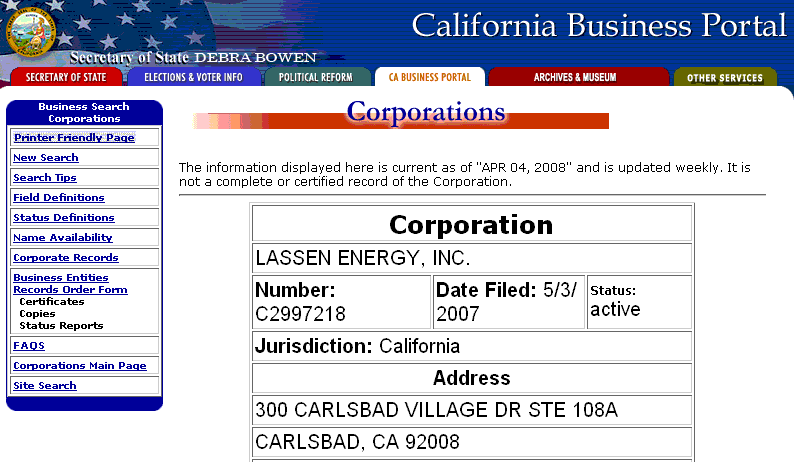
(screen capture 4/6/08)
Lassen Energy Stockholders (4/22/08)
Here is the
cast of Lassen characters from Edgar database April 18, 2008 (from a filing
related to reverse merger between Lassen and Natco). This is all the 32.375
million issued Lassen shares of one billion!! shares authorized. (Note
it says elsewhere in the filing that Boyd has (paid for) the 14.7 million
Lassen shares by transferring all his rights in the 3,000 watt (DBK) solar
panel patent application to Lassen.)
DBK Corp
Darry Boyd, CEO
14.7 million
Resource
Capital Development
Ronald D. Lewis
6.3 million
Capital Group
Communications
Devin Bosch, president
5.25
Peter Kristensin
1.75
Briton McConkie
1.75
Joseph Martin, LLC
& Steve Careaga
1.75
--------------
subtotal 10.5
10.5 million
Otto Law Group
David M. Otto, president
0.875 million
601 Union Street
---------------------
Seattle, Washington
total 32.375 million shares
The plan of this date was for Natco to acquire all of Lassen stock in exchanged for 323 million Natco shares and Darry Body was to become CEO of Natco.
David M. Otto
David M. Otto
did legal work for the Natco/Lassen reverse merger. He is listed as owning
nearly 3% (875,000 shares) of the outstanding Natco shares, which he probably
acquired as payment for his legal work. The Natco International SEC filing
Form 10-KSB of 3/31/2008 states that the signing of the (reverse merger)
is to be "held at the offices of The Otto Law Group".
Well the SEC is not too happy with Mr. Otto. In July 2009 the SEC filed suit against David M. Otto in connection with a small company stock (MitoPharm Corporation). SEC charges Otto with "orchestrating" a "pump and dump scheme" by fraudulently promoting non-existent anti-aging products that made him a million dollars. Below are SEC/Otto links: SEC web site and the SEC court filing:
http://www.sec.gov/litigation/litreleases/2009/lr21126.htm
http://sec.gov/litigation/complaints/2009/comp21126.pdf
The SEC site entry begins:
U.S. SECURITIES AND EXCHANGE COMMISSIONSummarizing the Lassen Energy(P2Solar)/DBK Solar relationship
Litigation Release No. 21126 / July 13, 2009
Securities and Exchange Commission v. David M. Otto, Todd Van Siclen, MitoPharm Corporation, Pak Peter Cheung, Wall Street PR, Inc., Charles Bingham, Case No. CV-09-0960 RAJ (WD Wa. filed July 13, 2009)SEC Charges Seattle Attorney (David M. Otto) and Accomplices With Orchestrating Stock Dumping Scheme
What do you suppose are the odds that Lassen Energy/P2Solar is another front company of DBK Solar's Darry Boyd? I'm betting 100%.
P2Solar's whopper claim
Here is P2Solar
(only) current project according to its web site (4/6/08).
"Lassen County Project is ongoing project which consists of 200 megawatts of clean green solar hydrogen energy. We are currently in the permitting stages of this project and hope to break ground before the end of 2008. This plant will be the largest in the world when completed supply clean green renewable energy 24 hours and 7 days a week." http://www.p2solar.com/index.php?option=com_content&task=view&id=52&Itemid=55For perspective currently the largest solar panel sites in the world are in the 5-10 Mw range. This plant is (supposedly) to be 20-40 times bigger! Gee, I wonder why at this size it doesn't get more press than this announcement on the P2Solar site. And isn't this the same 200 Mw solar plant that the Lassen County News reported in Nov 2005 was to break ground in spring 2006 and hasn't reported on since?
And gee, officials of Lassen County in 2007 don't seems to know anything about plans to build the world's largest solar plant in their county. I wonder why? Here's a screen capture from a presentation of public officials of Lassen country about renewable energy projects in the country, dated Mar 2007 (link here) . Clearly no mention of a Lassen 200 mw solar plant.
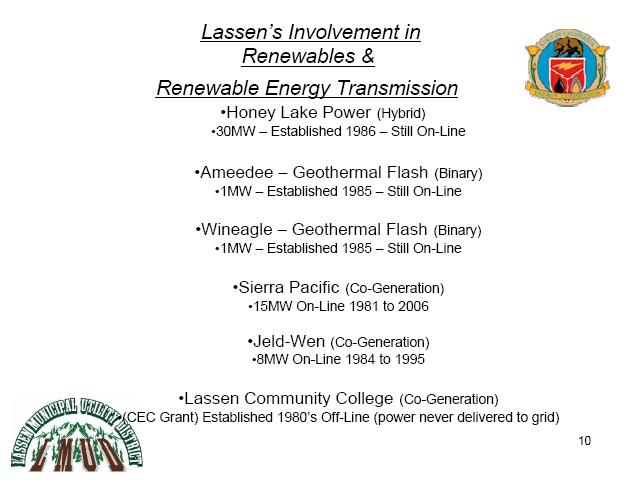
(from a March 5, 2007 presentation to California Energy
Commission by Lassen County's Frank Cady)
DBK Solar early claims & ties to Lassen County
(4/5/08)
DBK has been
making absurd claims as far back as 2005. This information comes from 2005
and 2006 articles in a local newspaper in Lassen County CA (northest corner
of CA).
"The largest solar power plant in the world is scheduled to break ground in April of 2006 near Amedee Field in Herlong (Lassen county CA)...Plans are in the works to make the plant a 200-megawatt unit!!" (Lassen County News, 11/1/05)http://lassennews.com/News_Story.edi?sid=2931
"DBK Corporation originally announced plans to construct the world’s largest solar power plant near Amedee Field back in November 2005." (Lassen County News, 2/27/06)
"According to its Web site (as of Feb 2006), DBK Corporation “is a designer, manufacturer and builder of alternative energy systems: solar panels, solar systems, fuel cells, solar based fuel cell generators and solar based fuel cell power plants in California, America and throughout the world.”(Lassen County News, 2/2706)The Feb 2006 article also says that DBK Corp, represented by Darry Boyd (identified as an engineer with DBK Corporation), was making an unsolicited offer to buy 134 acres in Lassen county from a local community college for $98,000.
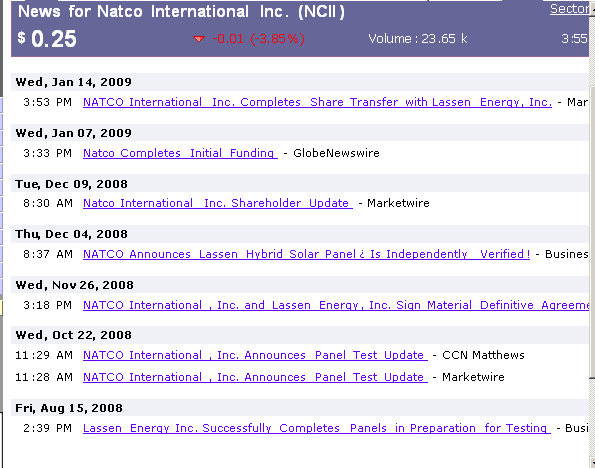
Natco
announces Lassen Hybrid Solar Panel Receives Independent Verification (12/4/08)
Below is the big
12/4/08 announcement (mentioned above) where the long awaited test results
of the super duper solar panel are in. Guess what, Natco's CEO Gurm says
the "prototype (panel) tested as we anticipated it would" with power at
2,704 watts!
Lassen Hybrid Solar Panel Receives Independent Verification (12/4/08) NATCO International Inc (NCII.OB)
Today, NATCO International excitedly announced that it has received an independent third party report that verifies the performance of the Lassen Hybrid Solar Panel(TM). According to the press release, the tests indicated up to 208 volts and over 2,000 watts of power output.
Raj Gurm, CEO of NATCO, stated, “We are pleased that the Lassen Hybrid Solar Panel(TM) prototype tested as we anticipated it would. We will now move forward with additional development that we envision will make solar energy a cost effective alternative energy source.”
The Lassen Hybrid Solar Panel was founded on the basis of Darry L Boyd’s inventions and innovations. As with all Photovoltaic systems, the panel relies on activating electrons to produce direct current (DC). The testing was conducted over a multiday period. Measurements averaged 13 amps and 208 volts, which calculates to 2704 watts, with peaks over 3,000 watts.
While the average cost per Watt in the United States is approximately $4.83, the Lassen Hybrid Solar Panel is anticipated to provide energy at less than $3.00 per Watt. It is also expected that only 1 to 2 panels will be required to generate enough electricity to power a typical U.S. residence, versus the 10 to 20 panels when using conventional solar technology.
NATCO International and its partner Lassen Energy Inc. are currently in the process of finalizing the Share Transfer and License Agreement and are working closely with each other to bring the Lassen Hybrid Solar Panel to the market with further development of prototypes and eventual UL certification.(Update 2/24/09) Phony web site promoting Natco/Lassen fraudulent solar energy technology
I just found this site:
http://www.cheapsolarstocks.com/
It pretends to be a general stock site, but it's not. It's a new phony site trying to sucker in the public to invest in Natco and their fraudulent technology. It has been put up by the scummy PR firm that represents these guys: Capital Group Communications. It you select Disclaimer you can see their banner. Here's the opening screen of http://www.cheapsolarstocks.com/
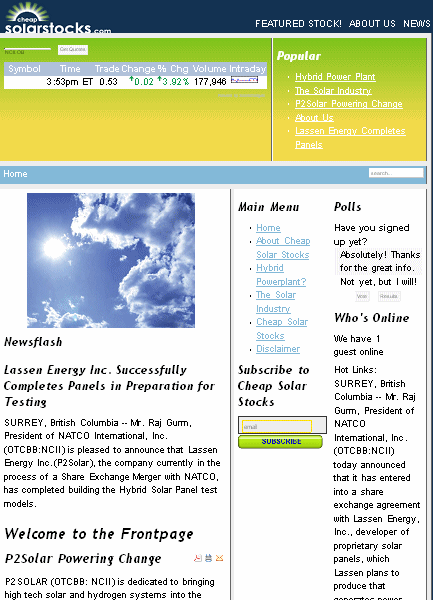
2/24/09 screen capture of phony site 'Cheap Solar
Stocks'
http://www.cheapsolarstocks.com/
(Update 3/20/09) Natco
=> P2Solar
For months
Natco International has been loosely using the name P2Solar, but today
according to the business press as of 3/18/09 it has officially change
its name to P2Solar Inc. "The new name better reflects the new business
direction of the company into solar energy." A new OTC symbol will be coming
replacing ncii.
The only other March news (remember this is four months after its super duper new solar panel passed its 3,000 watt tests!) is a guy named Hans Edblad, who appears to be a small company pitchman who has been associated with the company in the last year or so, has joined the board.
In recent months Darry Boyd's name has disappeared from all Natco International or P2Solar business announcements, now only Gurm is featured. At one point in 2008 Boyd was identified as the CEO of P2Solar. The Lassen link remains, however, with the share swap in Jan 09 and P2Solar calling their solar panel the "Lassen hybrid solar panel."
A link to Gurm smiling face with Edblad:
http://www.p2solar.com/index.php?option=com_content&task=view&id=55&Itemid=58
(update 4/22/09)
OTC symbol ncii => ptos
The change
of Natco International into P2Solar Inc continues with a change of their
OTC trading symbol. About 4/15/09 the OTC symbol has changed from ncii
(now invalid) to ptos. Initial price range of stock is about the same as
in recent past (38 to 46 cents).
On the business news front (4/7/09) we get below:
P2 Solar, Inc. Announces Government Approval to Build 25 MW Solar Power Station in Punjab, India
SURREY, BRITISH COLUMBIA -- (Marketwire) -- 04/07/09 -- P2 Solar, Inc. (the "Company") (OTCBB: NCII) is pleased to announce that it has submitted plans to the Indian State of Punjab for the construction of a twenty five (25) Mega Watt ("MW") Solar Power Plant. On March 20, 2009, the Company received governmental approval to build the 25MW Solar Power Station in the Indian State of Punjab. The present intention of the parties is to enter into a written agreement memorializing the terms of the project after May 20, 2009. The contract will include a Power Purchase Agreement for 33 years.
Mr. Raj-Mohinder Gurm, CEO of P2 Solar, Inc. stated, "We are extremely pleased to be working with the Indian Government with its need for electrical power. This initial phase of 25MW is part of a larger planned Power Station for the State of Punjab, and is being closely watched by a number of additional Indian States. We would like to thank all of the local, state, and federal agencies that assisted in making this project possible and look forward to working with them for years to come."Notice the almost total lack of content in above. No specifics on when or where plant will be built, what technology it will use, how much it will cost, or how it will be financed. Plans have been submitted, received government approval (boy that's clear) and it is our intention to write something down by May 20, 09 (another target date to keep up investor interest). The P2Solar web site as of 5/5/09 has the photo below:
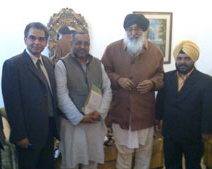
(far left) Mr. Raj-Mohinder Gurm, CEO, P2 Solar
(3rd from left) Mr. Parkash Singh Badal, Chief Minister
of Punjab
(source -- http://www.p2solar.com/index.php?option=com_content&view=article&id=57&Itemid=63)
25MW photovoltaic plant is huge
Note 25 MW
for a photovoltaic solar plant is huge. The big German solar plant pictured
above is only 6 MW, uses 100,000 panels about 60 watts each, and is one
of the world's largest solar plants. The Germans just (2008) completed
a 40 MW plants claimed to be the world's largest. So it's odd that in this
'business' announcement' there is no comment at all about the scale of
the
P2Solar plant. Maybe they just pulled a number out of the air, or maybe
this info is being held back, because the general plan appears to be to
dribble out little news tidbids for a long time.
Is P2Solar trying to distance itself from Boyd's phony
technology? (5/5/09)
It's curious
that in recent P2Solar announcements there is almost no mention of the
'revolutionary' 2,000 to 3,000 5x 3 ft solar panel that they claimed to
have built and successfully tested only months ago. Is Gurm trying to sweep
this solar fraud under the rug? Is he trying to put together a deal to
actually build a real solar plant in Punjab, using of course real solar
panels, putting himself forward as some sort of solar manager?
There's this curious entry in Gurm's spring 2009 letter to stockholders:
04/05/09I wonder if maybe Capital Group Communication is bringing P2Solar together with another of its clients Premier Power, who is a solar integrator. This would open up the possibility that Gurm might be using his family contacts in India to (in effect) get them a solar job there? (He's sure not going to build a solar plant there with his phony hybrid solar panel.)
Company meets with Industry leading Solar Integrators to further enhance its maintenance and consulting services by being able to offer a wider variety of solar solutions to government and municipal power projects.
Or perhaps the guys in the picture above are just his cousins? Who knows. He comes from Punjab, and he likely went back to Punjab to visit his family.
DBK Solar update (5/5/09)
DBK Solar
web site main portal is down and has been for a while. Parts of the site
are still up. If you want to buy a DBK Solar dealership, Boyd will take
your money. Looks like Boyd is slowly killing off DBK Solar focusing instead
on his other, less tarnished, front company Lassen Energy, which as luck
would have it has exactly the same 3,000 watt solar technology.
If press announcements are to be believed (I take them with a big grain of salt), Boyd has managed to put some change in his pocket by getting somewhere between 200k and one million from P2Solar (Gurm) for limited rights to use his phony Lassen/DBK Solar solar technology.
Spring 2009 P2Solar letter to stockholders (May 2009)
Gurm has posted
a letter
on the P2Solar web site that purports to review company milestones over
the last 12 months. It's largely fiction. It totally whitewashes the extensive
connections with Boyd that were reported by Natco to the business press.
Boyd it had been announced was going to take over Natco as CEO and owner
of more than 90% of the shares in a reverse merger. Other Natco reports
had said Gurm paid 200k to one million to Boyd for his technology. Somehow
Gurm forgets to mention any of this. Also all references to the fraudulent
spec (2,000 to 3,000 watts from a 3x5 ft solar panel) are gone. Certainly
Gurm is distancing himself from Boyd and Lassen Energy, which is also not
mentioned. Is Gurm trying to go legit? Well not entirely, because
there's this:
04/15/09In the winter construction and testing of the panel had been strung out for many months until it had been announced that it had successfully passed all its test. Now from above it appears the whole procedure is to start all over again with more tests leading to 'certification and proof of product'.
Company funds additional testing and development of advanced Hybrid Solar Panel for certifications and proof of product under licensing agreement.
My guess is that Gurm is going to try and sell a conventional solar plant in India, perhaps either built by or with technology from Capital Group Communication's client, Premier Power, though where the extensive funding is to come from is a total mystery. Meanwhile to keep up stockholder interest there continues to be vague talk about continued development of their terrific new solar panel.
Capital Group Communications P2Solar/Natco stock (5/25/09)
Here is info
(linked from Disclaimer page of Cheapsolarstocks web site) which shows
how much P2Solar and Natco stocks Capital Group Communications owns, so
any increase in the price of the stock benefits them directly. They state
that they may sell stock (whose price they work to pump up) to the general
public. Since Natco has evolved into P2Solar, it's not clear whether the
2 million Natco shares CGC owned were converted to P2Solar and are in addition
to the P2Solar shares they list. (The price of P2Solar stock recently has
been in the range of 25 to 50 cents a share.)
Corporate Name:
Natco International, Inc.
Symbol & Exchange: OTCBB:
NCII
Coverage Initiated:
March 24, 2007
Compensation:
CGC has been compensated 1,500,000 shares of RULE 144 restricted common stock of NATCO International, Inc. for the coverage and dissemination of information and other consulting services. Our coverage initiated on March 24, 2007. CGC shares are freely tradable and CGC intends to sell shares to pay for services. There may be a conflict of interest as CGC may be selling its shares to cover expenses while still profiling the company. Please be aware that Any communications, profile and purchases while CGC has the ability to sell could create pressure on the stock.
Corporate Name:
P2Solar
Symbol & Exchange: OTCBB:
PTOS
Coverage Initiated:
March, 20 2009
Compensation:
CGC has been compensated 500,000 shares of RULE 144 restricted common stock of P2Solar for the coverage and dissemination of information and other consulting services. CGC also receive 500,000 restricted shares for services rendered. Our coverage initiated on March 20, 2009.
Having it both ways ... P2Solar Annul Report Form 10-K
filing (7/15/09)
Quite a year
--- no sales, no revenue, cash on hand is "nil", still in their tiny office
(900/month rent), 2 million in debt. Only able to raise 230k of the one
million they promised to pay con man Boyd to build and sell the non-existent
Lassen solar panel in Hawaii and India. They carry the solar panel licence
(even though they haven't fully paid for it) on their books as a one million
dollar asset (oh, yea!).
As I guessed earlier, P2Solar is trying to have it both ways. On the one hand they say they will spend the next year preparing to build and sell the new technology Lassen Solar Panels, but they leave themselves a trap door exit. The solar panel only becomes available, and they only have to pay the 770k they owe to Boyd for the license, after they receive a report from Interkek indicating that the Lassen Solar Panel has received Intertek Certification (elsewhere call UL approval) and has a power output of a "minimum of 1,500 watts". Then they say:
"In the event that the Lassen Solar Panel is ready for commercial applications when the Company begins construction on the 25 Mega Watt power plant, the Company anticipates utilizing the Lassen Solar Panel in the project. However, if the Lassen Solar Panel is not yet ready for commercial applications, the Company will utilize currently available commercial solar panels for the construction of the project."So a one man company with no money, no relevant expertise, is planning to build a 25 megawatt solar plant in India using conventional solar panels. Of course, no signed contracts. The report filed with SEC mid July says the India solar contracts were expected to be signed early June!
It looks like all that Darry Boyd made out of this stock/licensing deal is 230k minus legal fees. Probably not the big haul he hoped for a year ago.
Big bucks
Somebody probably
making many million with this stock. According to the 7/1/5/09 10-k filing
P2Solar has about 36 million shares outstanding. The stock recently his
70 cents a share, more than double a few months ago, so that's a capitalization
of 25 million for this worthless piece of crap! Can you say stock
manipulation? They report 50 shareholders of record.
Other tidbids from 7/15/09 10-K
-- The 200k
paid to Boyd (of the 1 million owed for license) came from a private sale
of more shares of P2Solar stock @ 30 cents/share + warrants.
-- Lassen
solar panel is still in "developmental stage".
-- Plan to
build factories to make solar panle, but will only start after the
panel receives UL stamp (which of course means they never have to build
the factories.)
-- There's
this amazing paragrah (under Products) of jibberish:
"The Lassen Solar Panels are currently in the development stage and are not yet ready for commercial distribution. Lassen is in the process of obtaining UL Certification for the Lassen Solar Panel. The Lassen Solar Panels contain components which make use of a patent pending application of a technology called Multiple Energy Levels or MEL, which configures photovoltaic cells (PV) as a series of transistors instead of as diodes.-- Due to the fact that the Lassen Solar Panel is still in the developmental stage, we do not currently have any customers. Due to the fact that the Lassen Solar Panel is still in the developmental stage, we do not currently have any suppliers. (even though DBK Solar has clamied to be making deliveries for years!)The technology takes wavelength frequency to move a bucket of electrons through the junctions, which greatly improves photovoltaic efficiency. The panels use this increased efficiency as a catalyst to generate, in current prototypes, 400 watts per panel, with construction of new panels currently underway that are designed to produce 2000 to 3000 watts per panel. A photovoltaic device (generally called a solar cell) consists of layers of semiconductor materials with different electronic properties. In a Lassen Solar Panel there are two parts. Part A, which we call “the cornerstone”, is a multi-junction, multi-layer device. Part B, which we call “the legacy”, (in earlier filing Part A was the legacy!) has previously stored energy in it. Part A and B are tied together in a photosynthesis arrangement to release in excess of 2000 watts of energy."
-- Once we begin manufacturing the Lassen Solar Panel, pursuant to the terms of the License Agreement, DBK is required to supply us with all of the necessary raw materials related to the manufacture of the Lassen Solar Panel.
-- Once we begin manufacturing, distributing and selling the Lassen Solar Panel in the Licensed Territories, our initial primary customer will consist of DBK Corp. Pursuant to the terms of the License Agreement, the Company has the right, but not the obligation, to require DBK Corp. to purchase not less than 91% of the Lassen Solar Panels produced by the Company each quarter.
(P2solar's supplier problems are solved because DBK must supply them with all the materials (& they have a licence and know how). P2Solar's customer problems are solved because DBK must buy at least 91% of what P2Solar manufacturers. What a deal, who thinks up this stuff? How come none of this was in the shareholder letter?)
-- On the residential and commercial side, our chief competitors are British Petroleum and Shell, both of which have substantially greater financial, manpower, and marketing resources than we do. Our ability to compete with them will be based solely on the hope that the Lassen Solar Panels are significantly technologically superior to any solar panels they develop. (Wait wasn't there weeks of testing and suspense last winter followed by confirmation that the solar panel tests were sucessful with the panel puting out its rated 3,000 watts. Now all of that is forgotten!)
-- The company has no full or part time employees (& 25 million stock capitalization).
-- The Company does not have sufficient assets or capital resources to pay its on-going expenses. Additionally, the Company does not currently have the $770,000 to cover the final payment that will need to be paid pursuant to the terms of the License Agreement.
-- Additionally, the Company anticipates that it will attempt to raise 2 to 3 million dollars through the sale of the Company’s securities to both cover the Company’s operating expenses, and to make the $770,000 payment pursuant to the License Agreement. (whoops, more dilution comng)
-- Our auditors' report on the March 31, 2009 financial statements includes an explanatory paragraph that states that as we have suffered recurring losses from operations, substantial doubt exists about our ability to continue as a going concern.
-- The Company (as Natco) discontinued operations of its jewelry cleaners and accessories line due to lack of demand for the product in March 2006. The tire sealant operations were also discontinued in February 2007.
--On November 28, 2008, the Company cancelled the reverse merger agreement with Lassen Energy and signed share exchange and licensing agreement with Lassen Energy, Inc.
-- On January 13, 2009, the Company signed a Compensation Agreement with Capital Group Communications (“CGC”) of Sausalito, California, pursuant to which the Company agreed to compensate CGC for past consulting services rendered by CGC and for introduction to and assistance with the negotiations with Lassen Energy (as I had speculated) with the issuance of 500,000 shares of restricted common stock. (Another 500,000 sharers were issued to CGC a couple of month later for a year of investment services)
-- Ownership
of P2Solar by insiders (March 09)
Gurm
7.2 million shares
18.8%
Lassen Energy
8.9 million shares
24.5% (in process of being cancelled)
Pidersky (director) 738 thousand
2.0 %
Edblad (director)
0
0
------------------
Insiders total 45.3%
(So with 25 million stock capitization,
Gurn has equity of 5 million and Boyd maybe has 6 million, but supposedly
the there is a long.... process to termination these shares because the
reverse merger fell through).
Add to above 1 million or more shares owned by the PR/investor
guys.
P2Solar update (11/6/09)
Use of motor loads
Here are two (low resolution) photos from P2Solar web site I recently captured.
 .
.
caption: "Hybrid Solar Panel prototype version 2 at
demonstration in Phoenix, Arizona, USA"
captured 11/5/09 form http://www.p2solar.com/index.php?option=com_content&view=article&id=56&Itemid=62
While it's hard to see in these photos, the solar panel in this demonstration appears to be hooked up to three small motors on the table, which presumably are rotating using power supplied by the solar panel. In 2008 P2Solar (then Natco) announced the test results of its new solar panel: NATCO Announces Lassen Hybrid Solar Panel™ Is Independently Verified!, Dec 4, 2008. Motor were used to load the panel during these tests too, the announcement saying: "six (6)-half (1/2) horsepower Dayton motors and four (4)-500 watt Lithonia lights were attached to the panel."
It's possible the motors in the pictures are the same 1/2 hp powers used in the panel test. A 1/2 hp motor can do about 1/3rd kw of mechanical work (1 hp <=> 746 watt), so how much power do you think is flowing from the panel to the three motors? 1 kw? Nope, more like 50 to 100 watt total for all three motors! Why so low? Because [Power = Torque x Speed] and the motors appear to have nothing connected to their rotating shafts. This means the torque load on the motor is very low, so with Torque low Power is low even though Speed may be high.
Bottom line --- The three motors shown, even though they may be spinning fast, are probably all running on only 50 to 100 watts (total) from the panel. Any solar panel this size can easily output 50 to 100 watts. Some demo! The use of motor loads may look impressive, but can be very deceptive because if a motor is unloaded it will draw only a tiny fraction of its nameplate power.
So an interesting question is why does P2Solar use motors both to show off its panel and to test it? I think the answer is obvious.
Update Lassen energy project --- 200 MW solar field
Here's a recent
screen capture from (as you see from the URL) P2Solar.com discussing the
upcoming 200 MW Lassen energy project..
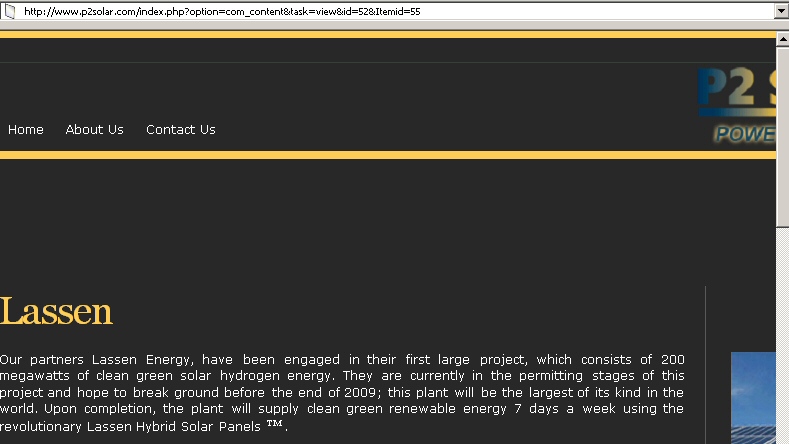
screen captured 11/6/09
Several things are interesting here.
Notice planned ground breaking on the 200 MW world's largest solar field (in USA, Lassen county is in the northeast corner of CA) is less then two months away from screen capture date and the link to the project has recently gone from the P2Solar home site. So where did the above screen come from? I stumbled on the link to above via CheapSolarStocks (another P2Solar site).
The link to the world's largest solar project just disappears from the P2Solar page a couple of months before planned ground breaking. Oh, yea! Well, the end of 2009 was the latest date for ground breaking, previous announcements had it at end of 2008 and even before that. Also I never see a delay announcement for the Lassen project, it's just the next time I look the ground breaking has moved out another year.
Notice also it states it was to be built using the Lassen Hybrid Solar Panels. These are the solar panels that supposedly have been verified (to P2Solar's satisfaction!) as being able to operate at greater than 100% efficiency. I don't think so babe! Gee, do you think that the fact that the project was planned around solar panels that violate the laws of physics has an bearing on the repeated delays of the project?
P2Solar shill
Wall Street Journal article: India’s Big Push for Solar Power (and Coal)
June
17, 2009. Here one of the six posted comments to the article (nothing
like being subtle)
SolarSon wrote:Form 10-Q quarterly report (11/19/09)
There’s a company that trades on the otcbb called p2solar (symbol=ptos) P2 Solar is currently working on its initial approval to construct a 25 MW Solar Power Station in Punjab, India. It is only phase 1 of a much larger planned Power Station for the region. It is my opinion that this company is a reeeaaaaalllllllllll sleeper…
Pursuant to the Agreement, the Company is now required to pay the remaining $770,000, ninety (90) days after the Company receives a report from Lassen indicating that the Lassen Solar Panel has received Intertek Certification and has a power output of a minimum of 1,500 watts. (Form 10-Q 11/19/09)Testing miracle panel at Intertek
Fake the test at Intertek?
Boyd might
try and fake the power testing at Intertek as he apparently has done in
demos for DBK dealers, but I see a real risk in this for Boyd. Wow, the
technician would tell his boss, I just measured an unbelievable amount
of power from a solar panel. The boss would come arunning. Word would get
around Intertek that they were about to verify a solar panel with
> 100 % efficiency! The resulting stir would huge. With more testing the
fraud would be exposed. Nope, Boyd is not going to fake > 1,400 watts out
of the panel with professional test engineering watching him. But
I can think of other, safer, approaches.
Intertek
I was not familiar
with Intertek so I checked their web site. They do in fact offer at a test
facility in CA safety and EMC certification of photovoltaic panels along
with performance and efficiency testing. The link below lists the photovoltaic
services they offer. You can buy what you want from them. If you request
safety certification or EMC testing, then that's what you get. (The type
of test would require the panel to be loaded to 100% capacity, but
that number depends on what Boyd tell Intertek is the panel's power rating.)
You get efficiency and power testing only if you request and pay for it.
http://www.intertek.com/energy/photovoltaic/
One way to fake it
Note the 10-Q
wording--- "report from Lassen indicating that the Lassen Solar
Panel has received Intertek Certification and has a power output
of a minimum of 1500 watts".
This wording, as I read it, is a little vague as to what Intertek must certify. For example, Boyd could deliver to Gurm a report showing Intertek has done some testing and that it 'certifies' the panel for, say safety or EMC, but [power out > 1,500 watts] certification is provided not by Intertek, but by Boyd who 'self certifies' (regulatory jargon) as manufacturer. Essentially Boyd just types up on fancy paper stating that the panel manufacturer (which is him, because he has likely modified a conventional panel in some way) 'certifies' the power out, perhaps with some perfunctory test description, and adds it to the report. Self certification is not uncommon when safety is not involved. The fact that this is a 'self certification' might either be omitted or relegated to a footnote. Regulatory testing is full of confusing jargon and standards. Would Gurm, or anyone without a background in electronics, pick up on a feint like this. Maybe, or maybe not.
Why 1,500 watts?
The power
level of the miracle panel keeps dropping -- DBK spec was 3,000 watts,
then later P2Solar PR had it at 2,500 watts, now it's down to 1,500 watts.
This still implies > 100% efficiency for a 5 x 3 ft solar panel (if
light is unconcentrated), so it matters little to its feasibility.
I kept rolling around in my head why this meaningless change from 2,500
- 3,000 watts to 1,500 watts for the Intertek test, then it hit me.
Another way to fake it
If Boyd ever
does have the panel power tested by Intertek (big if), then the change
of the pass/fail threshold to 1500 watts makes it easier for him to doctor
the report to convince the rubes he 'passed'. The P2Solar panel in pictures
is a silicon crystalline type and will measure around 175 watts. Boyd just
needs to add a '0' to the power line in the report, 175 => 1750.
Q.E.D.
------------------------------------------------------------------------------------------
New DBK/P2Solar front sites (update 2/18/2010)
Doing a little Googling I discovered two new DBK/P2Solar related sites:
A company (presumably authorized by Darry Boyd) is offering to sell the DBK 3,000 watt solar panel JIL-3000. Price is $35,795. The kicker is they are taking order for Mar and April 2010 and says Feb 2010 (orders have been) "Filled" (Oh yea!) Good luck on getting a firm delivery date! --- (http://www.ige-enterprises.com/panelodr.html)
Another site appears to be a front site for either DBK or P2Solar. It gives the full spec of the 3,000 watt DBK JIL-3000 solar panel, which P2Solar licensed the rights to. The spec is pretty much the same as on the original DBK site, but the output voltage is now shown as 240 VDC vs 220 VDC. Oh, and they are selling dealerships too, just like the old DBK! --- (http://www.supersolarindia.com)
----------------------------------------------------------------------------------------------
Boyd's demo test panel (2/18/2010)
Boyd has taken
down his large DBK site and has replaced it with a single page. This page
links to an interesting video (from equipment maker FSM Solar) showing
robotic equipment assembling a solar panel. If you compare the look of
the solar panel in the video to the solar panel in pictures on various
DBK and P2Solar sites, it looks identical. Hence it is very likely that
the JIL-3000 solar panel Boyd is using for his demos was assembled on FSM
equipment. FSM Solar is not a solar panel manufacturer, they are an equipment
builder who sell to solar panel manufacturers.
Boyd's new DBK site also mentions Spire. This is a family of NH companies, Spire Solar that makes photovoltaic manufacturing equipment, and Spire Semiconductor that makes the cells themselves, so they were likely involved too.
http://www.spirecorp.com/spire-solar/index.php
-------------------------------------------------------------------------------------
P2Solar's
new investor relation firm (5/26/10)
P2Solar recently
announed a new investor relations/PR firm, CCG. CCG
appears to be a larger and more reputable firm that the previous investor
relations guys in CA who also represented Darry Boyd. CCG is based in US
but have seven offices around the world with three of them in Asia. Here
CCG's self-description from their web site.
About CCG Investor Relations---------------------------
CCG is one of the nation’s leading investor relations and strategic communications agencies. In business for more than 30 years, the agency provides a complete range of investor communications and counseling services to over 40 clients on the New York, American and NASDAQ stock markets. CCG has been awarded a number of industry honors for its handling of complex investor relations and crisis communications matters. The agency’s corporate headquarters is in Los Angeles with additional offices in New York, Hong Kong, Beijing, Shanghai, Tel Aviv, Newport Beach, California, Dallas, Texas and Columbia, North Carolina. CCG is also the managing partner of two joint ventures.CCG Elite has a staff of 20 professionals and 40 clients and provides best practice investor relations services to a growing number of Asian companies seeking to access the U.S. capital markets. CCG-K has 20 clients and provides global investor and public relation services to Israeli-based companies that are public or seeking to list in the U.S. stock markets. For further information, contact CCG directly, or visit the Company's Web site at www.ccgir.com. (Crocker Coulson is identifed on the web site as president of CCG Elite)
Mr. Crocker Coulson
Date: May 30, 2010
Re: CCG's new client P2Solar
Since 2008 P2Solar and its CEO, Raj Gurm, has been involved with a character named Darry Boyd, who's some sort of cross between a crackpot inventor and con man. SEC filings of Natco International (P2Solar's prior name) in 2008 show that Boyd was to become CEO of a new SEC registered company created by reverse merger of Raj and Boyd's companies. When that fell through, Raj bought a license to a super duper solar panel Boyd claims to have invented and had promoted though his (one man) companies, DBK Solar and Lassen Energy, which Boyd ran out of a UPS post office box.
P2Solar's Boyd licensed solar panel is connected to P2Solar's current India project. P2Solar filed with the SEC (Form 10-k, July 2009) saying it would use its super duper solar panel in its 25 Mw India solar project if the panel was ready. Boyd's claims for this super duper solar panel are that it can put out more than ten times (ten times!) the power of competitive solar panels the same size. Obviously if such a solar panel existed it would be a game changer, since it would reduce number of panels and the land area of the solar field by more than a factor of ten! Of course the super duper panel isn't ready [and never will be], but to the best of my knowledge P2Solar hasn't bothered to tell its investors that it's not using it in India.
The magic number in the solar industry is 1,000 watt/m^2. Everyone in the solar industry knows this number (except Raj?). It's the power contained in bright sunlight and is the light level used to test solar panels. The area of a 5x3 ft solar panel is about 1.3 m^2, so any claim of more than 1,300 watts out of a panel this size is the solar equivalent of a perpetual motion machine; a claim that you can get out more power out than the sun puts in. It's theoretically impossible, a violation of the laws of physics, no engineer can circumvent it. Boyd for years has claimed that his 5x3 ft solar panel outputs 3,000 watts (vs 200 watts for competitive panels this size). This claim is fraudulent 'on its face'. Yet Raj, whose bio indicates he has technical background (degree in biology), licensed this phony solar panel for a million dollars (230k paid to date), transforming his jewelry cleaning company into a 'solar' company, and then spent over a year talking up its potential to his investors. I can only conclude that he is either in on the fraud or is willingly blind.
I've been tracking and documenting Boyd's solar fraud for years. A while back I wrote up a report on Boyd's solar fraud and on the advice of my local police took it to the FBI. I sent it to Raj too. I have also filed an SEC report about the fraudulent claims for this solar panel, naming P2Solar.
I am curious about your company taking on such a client. Is it that you don't care if your clients are involved with fraud or did your DD not discover (or understand) just how absurd are the claims of the super duper solar panel P2Solar has spent big bucks licensing and claims as a valuable asset? To check out what I am telling you, try Googling 'Solar Scam' or check out the solar fraud essay at the link below.
Ref 1
http://twinkle_toes_engineering.home.comcast.net/dbk_solar.html
Ref 2
"We are excited
to be working with a client engaged in the solar energy industry within
a market like India which has incredible growth opportunities," said Crocker
Coulson, President of CCG. "We are confident P2 Solar is well positioned
to establish itself as one of the leading suppliers of solar energy in
Punjab, India and will maintain effective communications with investors."
----------------------------------------------------------------------------------------
PR
firm indicates P2Solar to abandon Boyd's solar panel
Subject: Re: P2Solar
From: crocker.coulson@ccgir.com
Date: Tue, 1 Jun 2010 06:00:00 +0000
Thanks for sharing your concerns. Pierre who covered the solar industry for years had similar reaction when he uncovered this background.
We are aware of this past history and have advised the company that we do not consider it to be possible that such a technology could be viable in our universe. They are not currently putting any focus or resources on this area.
The company is planning to build the indian solar generation plant using conventional PV technology and their jv partner from korea has a very solid reputation of building large scale solar plants.
I believe that Raj's business strength is to secure the contracts to construct the solar plants benefiting from very favorable new feed in tariffs in India. It will be very clear in next few months if they can secure the first 2MW contract in Punjab and we will know by sept if they can get national level qualification to build a 25 MW plant. If they do receive these contracts it should be an attractive business given that their partner will handle design and construction of facilities and P2 will handle land rights acquisition and govt relations. The economics and ROI under new tariff appear quite compelling.
This is an early stage but fairly straightforward business plan and the proposals they submitted to Indian government are quite professional.
I have not been able to discuss the history with Boyd directly with Raj as he has been in India and I have been in China -- but will discuss when he comes to NY in June.
Thanks for your concern and valuable background info. Best regards,
Crocker Coulson
President
CCG INVESTOR RELATIONS
1325 Avenue of the Americas
Suite 2800
New York, NY 10019
www.ccgir.com | www.ccgirasia.com
---------------------------------------------------------------------------------------
My 6/1/10 follow up email
Crocker
I appreciate the detailed reply.
My comments:
Firstly, as to putting the fraudulent solar panel behind them, I just looked on the P2Solar web site, and it has on it today a picture of Boyd's super duper solar panel with Boyd next to it.
Second, note (below) how Gurm says he "anticipated" the absurdly high level of power (2,700 watts) from the panel. And he apparently feels no need to even comment on how this panel was able to circumvent the laws of physics, how it was able to put out more power than the sun brings in. These are big fraud red flags. (As Markopolos, the Madoff whistle blower points out, being willfully blind is no defense.)
Third, Gurm (below) distinctly gives the impression in his Dec 2008 PR announcements that an independent 3rd party tested the solar panel and verified its (high) power output.
This is not consistent with my information. I have seen what purports to be this 3rd party report. It is just a short statement from a community college professor who observed the test. He did not perform the test. This is not a quibble. Boyd himself (I suspect) ran the test. For nearly five years Boyd has doing solar demos that supposedly demonstrate his panel can put out 3,000 watts. As a professional power engineer, I know his panel test setup is bizarre and potentially deceptive. Whether he does this deliberately to fool the rubes, or whether he is so unskilled he is fooling himself I cannot say.
The fact that Gurm publicly relied on a single 'verification' of these barely believable, out-of-this-world power measurements after a year's work speaks volumes (to me) about his integrity.
If he now is going straight, maybe its time for a candid "forget all that shit I told you about the panel" business announcement to his investors. Time to write down the value of the Boyd license asset to zero. Come clean, admit he latched onto and puffed up semi-unbelievable solar panel claims to get into the solar business.
Bottom line --- fraud is fraud.
---------------
(attachments to above email)
(Natco 2008 business announcements)
6/26/08 "This is an exciting time for us and our shareholders as we anxiously await the outcome of the results from the hybrid solar panels." says Raj Gurm.
12/4/2008 Today, NATCO International excitedly announced that it has received an independent third party report that verifies the performance of the Lassen Hybrid Solar Panel(TM) ... Measurements averaged 13 amps and 208 volts, which calculates to 2,704 watts (3,000 watt peaks). Raj Gurm, CEO of NATCO, stated, “We are pleased that the Lassen Hybrid Solar Panel(TM) prototype tested as we anticipated it would."
(followup Natco release later in Dec 2008). The
individual who conducted and verified the test is a currently employed
professor of electricity.
---------------------------------------------------------
(update 7/18/2010)
A poster (who
is not me) to the P2Solar forum on Investor Hub has looked at the recent
P2Solar SEC filing (10-K, July 14, 2010) and makes some good points. The
SEC filing (see below) shows that P2Solar has not cut its ties to the phony
solar projects, to Boyd or Boyd's solar panel contrary to the assertions
of the P2Solar's PR people. I screen captured the post on the day it was
posted, because such posts have a way of rapidly disappearing from the
forum.
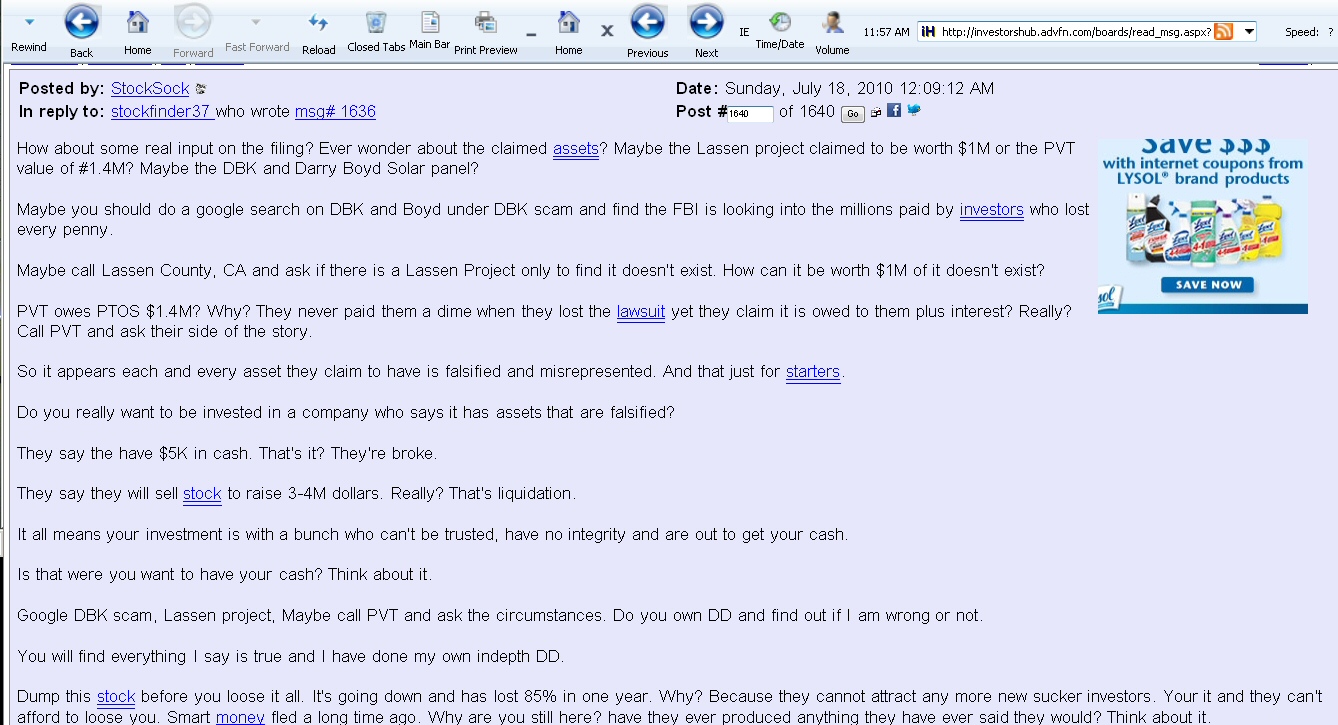
Investor Hub P2Solar forum, screen capture 7/18/2010
This page comes up 3rd when Googling 'DBK Scam'
10-K SEC filing of July 14, 2010
The company
is still in the business of "manufacturing, distribution, and sales of
solar panels" (meaning Boyd's panel). Contradictory power numbers are given
for the Boyd panel. First it says that Boyd's "prototype" panel outputs
400 watts and that construction is underway for panels "designed to produce
2,000 to 3,000 watts". But a little later earlier tests of the panel are
detailed saying (or implying) it has been shown to output 2,704 watts.
It repeats the claim that if the Lassen solar panel is "ready for commercial
applications" it will be used in India, otherwise they will use "currently
available solar panels". No mention that the area of the solar field is
hugely different depending on which panel is used!
While it doesn't say so the mention of 400 watts in the 10-K is sort of a backhand confirmation that when Boyd submitted the panel to someone competent (Intertek), it measured nowhere near his claimed 1,500 to 3,000 watts. In fact its measured efficiency (in round numbers 20%) came out within the range of high efficiency commercial solar panels. Big Whoop. The first time Boyd's solar panel is measured by anyone other than him, it tests like any other solar panel!32 million shares are outstanding (market cap of approx 3 mil at today 9 cent/share). There are only 47 stockholders "of record". The company has "no employees", just management, which means Gurm. The licence agreement with Lassen is still on the books as a 1 million dollar asset. The company details they have virtually no cash and are in debt (3,000 month interest charge). They say the don't have the 770k that would be due Boyd if he can get his solar panel approved, and they as an after thought they give the amount of capital they would need to build the (presumably 25 mw) Indian power plant as 112 million! Bizarre.
In fact I think 112 mil is too low for a 25 mw solar plant. Rough rule of thumb is that cost of a 1,000 Mw conventional power plant is about 4 billion, so a 0.025 x 4,000 million = 100 million, but solar costs are x6 to x8 higher than conventional power!They plan to issue more stock to raise 2 to 3 million dollars. At the current price of 9 cent/share this is a 50% dilution and potentially a much higher dilution if all this selling drops the share price further. One of the two (potential) uses of this money detailed is paying 770k to Boyd for the licence for the Lassen solar panel!
"The Company anticipates that it will attempt to raise approximately 2 to 3 million dollars through the sale of the Company’s securities to cover the Company’s operating expenses and to make the $770,000 payment pursuant to the (Lassen) License Agreement."I looked for the cost of preparing the India engineering (pre-feasibility) report under 'Operating Expenses'. A possible candidate is a 330k "consulting fee", but 173k consulting fee is shown for 2009. 450,000 shares were also issued in the last year to two people for "consulting". (Brainard last year received 200,000 options, suggesting this is how he was paid.) Nowhere in this nearly 50 page report does it say who prepared the India solar engineering report, nor is there any information about its content, scope or length. (The company does have loose relationship with a Korean solar company, so the info might have come from them, but if so its surprising they just don't say so.)
Salary numbers are confusing, but there are some large numbers that make it look like Gurm may be bleeding the company. Under 'Related Party Transactions' there is "wages and bonus payable to a director and officer of the company" of 689k and "loans payable to a director and officer of the company" of 223k. The only listed officer of the company is Gurm and he is also a director (chairman). The only other directors are Hans Edblad and Stephen Sleigh. Gurm owns 7 million shares (21.6%) of outstanding stock. Edblad and Sleigh own 0 shares.
In the 10-K ('Other significant events') it confirms what I have suspected that CGC of Sausilito introduced Gurm (P2Solar) to Boyd (Lassen) and they paid CGC with 170k of stock for the P2Solar/Lassen negations. The 10-K says (several times) that 770k is due Boyd 90 days "after the Company receives a report from Lassen indicating that the Lassen Solar Panel has received Intertek Certification and has a power output of a minimum of 1,500 watts."
8-K SEC filing of July 19, 2010
Reading the
10-K when I saw that Raj was (somehow) owed almost 700k I speculated that
Raj was bleeding the company. Five days later comes the 8-K filing and
it says this:
As of March 31, 2010, P2 Solar owed a total of $849,595.35 to Raj-Mohinder Gurm broken down as follows:Gurm appears to take a modest salary (about 60k) for now we find that for an unspecified period of time and for unspecifed duties he is somehow owed almost 700k! This dilutes stockholders by 1/3rd and raises Gurm's ownership of the company to (10 mil + 7 mil)/43 mil = 39%. Also what the hell was the interest rate on the loan. If the 165k was [principal and interest] and of that 115k is interest, then the principal must have been 50k. 115k interest on a 50k loan! (Does Gurm do a little loansharking on the side?)i) $165,132.31 in principal and interest in for funds loaned to the Company by Mr. Gurm; and
ii) $684,463.04 for past services rendered to the Company by Mr. Gurm in his capacity as an Officer of the Corporation.On July 15, 2010, the Company's Board of Directors authorized the issuance of a total of 10,000,000 shares of restricted common stock to Mr. Gurm in satisfaction of $800,000 of funds due and owing to Mr. Gurm. Specifically, the Shares were issued to satisfy $115,536.96 in interest due and owing to Mr. Gurm, and $684,463.04 in compensation due and owing to Mr. Gurm. The shares were valued at $.08 per share. Prior to the issuance of the Shares the Company had a total of 32,997,589 issued and outstanding. Following the issuance of the Shares the Company has a total of 42,997,589 shares of common stock issued and outstanding.
But wait, isn't 400 watts still extraordinarily high, indicating that maybe there is something to Boyd's claims of new technology? Doesn't 400 watts from his 1.3 m^2 panel (1.3 m^2 x 1,000 w/m^2 = 1,300 watt solar power coming in) means the efficiency is over 30%? Well no, read on.
In Feb 2010 I was sent a copy of what appears to be the Intertek test report of the Boyd panel by an investor Boyd was courting. I am a professional power engineer and I know how to read a report like this. Here's why the power number P2Solar reports (to SEC) is so high.
One, the panel tested was not the 1.3 m^2 panel size long speced by DBK. The panel tested is bigger about 1.8 m^2 or 30-40% larger. Two, the power quoted (400 watts) is not the real power from the panel, it is an idealized 'rectangular power' value. In devices with approximate rectangular curves, like motors and solar panels, this is shorthand value often used (along with real power) because it is easy to measure. The actual (real) power out is typically (varies a little) about 3/4th of the 'rectangular power'. So scaling from 400 watt value to the expected real power from the original size 1.3 m^2 panel, we get
400 watt x 0.75 (real power/rectangular power) x (1.35 m^2/1.8^m2) = 225 watts
There's nothing unusual about 225 watts from a 5 ft x 3 ft (1.35 m^2) solar panel. It's on the upper end of the commercial range, but anyone can buy one. Here's the gory details excerpted from my Feb 2010 email to the prospective Boyd investor.
Hi xxxxxx
Real DBK data, the first I have ever seen! On the title of your email, it's not really me vs DBK, because I am telling you what I think any power or solar engineer will tell you.
I have only looked at the Intertek report so far. Here's my thoughts on it. I am familiar with the Intertek web site and they appear to be a professional test house, and solar panel testing at the Lake Forest CA facility where the test was done is a specialty, so their results should be solid.
Scope of the tests
They, of course, only test for what Boyd paid for them to test. First, is this the whole report? one page? Reports like this usually run to several pages. The report says there were to do four tests: tests 10.2, 10,4, 10.5 and 10.6 of IEC standard 61215. I looked up these four tests in IEC 61215. These tests (in simple terms) are (so-called) maximum power, actual power, and variations with temperature. The only data appears to be just for test 10.2 (maximum power). Where's the rest of the test results for the other tests? There is also the very puzzling statement, "The current module does not allow short circuit operation limiting the ability of the IV curve tracer to measure the output." I take this to mean that something weird happened when they shorted the test panel, so that it restricted what they could test for. They then proceed in the table to give the short circuit current (Isc = 8.5A) after just saying that they couldn't measure it. It's all very puzzling.
With all those caveats let's look at the data.
The only numbers of interest are the first two measure at full sunlight equivalent (1,000 w/m^2) Isc = 8.5A and Voc = 52.7V. (The other two numbers are measured at reduced sunlight (800 w/m^2)). Yes you can multiply a voltage x current and get power [52.7V x 8.5A = 448 watts]. But this is not, repeat not, the actual power the panel will put out. It is what the IEC standard calls the "maximum power" of the panel, but this is very misleading. It's included in the specification only because it is easy to measure and it give an indication of the power a solar panel will put out, but it give a 'high' indication. The actual power of solar panels is typically (can't be more specific because the IV curve for this panel is not included) 70% to 80% of the maximum power. Look at the GE solar panel included in my DBK essay, or at the spec of the panel (below) and you can see what I mean. So scaling the 448 watts by 0.7 to 0.8 the actual panel power estimate is [448 x 0.7 to 0.8 = 314 to 358 watts]
Size of the panel
The dimension of the panel Boyd submitted for testing was quite a bit larger than the panel size Boyd normally specs. The report says the panel dimensions are [1.836 m x 0.982 m = 1.80 m^2]. This is a 1.8 square meter panel, so incoming light power at 1,000 w/m^2 is 1,800 watts (assuming whole panel area is active, may not be 100% true, but borders are generally small on solar panels). (When I have checked Boyd's panel dimension before I got between 1.3 and 1.4 square meters.)
Figuring the efficiencyhttp://us.sunpowercorp.com/downloads/product_pdfs/Panels/sp_315ewh_en_ltr_p_ds.pdf
Using the numbers above for our estimates of actual power we get the efficiency range to be [314 w/1,800 w = 17.4%] to [358 w/1,800 w = 19.9%]. Totally unremarkable. You can buy commercial solar panels with efficiencies as high as 22%. Check out the solar panel at this link made by SunPower.
The Sun Power panel above is 15% smaller than the tested panel. It's Voc x I sc = 64.6V x 6.14A = 397 watts. If we scale it up 15% to match the area of the tested DBK panel we get [1/0.85 x 397 watts = 467 watts], which is in the range, actually it's higher, than the 448 watts (maximum power) figured from the Intertek report.
Big Whoop! As soon as the panel is tested by anyone competent, it turns out to test within the range of commercial solar panels. Note the measured efficiency looks like it is about 10 times lower than the 200% efficiency Boyd has historically claimed!! To cover his ass Boyd gives you a dippy cover story that it was only half working. Right!! He's been running this scam for four to five years. Check out the letter I reprinted in my essay from the Lassen County News May 23, 2006. A Scott Forest chides the local newspaper that "DBK panel is impossible. The company DBK Solar is a fraudulent operation." This is a good year before I ever heard of DBK Solar. Boyd's a fraud and/or crackpot. Save your money.-------------------------------------
P2Solar jumps back into bed with Boyd & his phony
solar panel (update 10/31/10)
In June 2010
Crocker Coulson, President, CCG INVESTOR RELATIONS had advised me via email
that P2Solar was (in effect) putting Boyd's phony solar panel behind them.
Excerpts from Crocker's June 2010 email below.
"We are aware of this past history and have advised the company that we do not consider it to be possible that such a technology could be viable in our universe. They are not currently putting any focus or resources on this area. ... The company is planning to build the indian solar generation plant using conventional PV technology and their jv partner from korea has a very solid reputation of building large scale solar plants." (Crocker Coulson email to me, excerpts, June 2010)Well I guess that Gurm paid no attention to his new investor relations firm, or maybe Crocker was blowing smoke, because come Oct 29, 2010 and P2Solar puts out the press release below. It not only confirms that P2Solar is still partnering with Boyd, but the relationship is tightening with P2Solar (via Solarize) buying equity in another of Boyd's solar panel companies.
Quotes: It is "a significant advancement in the relationship between the Company (P2Solar) and the Developer (Boyd)" and "By expanding our involvement in the development of the technology, we are in a position to significantly advance this exciting and revolutionary solar panel."
P2Solar Press Release, 29 Oct 2010
P2 Solar Acquires Strategic Interest in Advanced Solar Technology
VANCOUVER, BRITISH COLUMBIA, Oct 29, 2010 (Marketwire via COMTEX) -- P2 Solar, Inc. (the "Company") (OTCBB:PTOS) is pleased to announce that it has acquired a 34% strategic interest in the advanced solar panel technology developed by Darry Boyd (the "Developer"). The worldwide intellectual property rights associated with this technology have been transferred to a newly incorporated company, Solarise Power, Inc. ("Solarise"), in which P2 Solar has joint control of the Board of Directors and management affairs.
This acquisition represents a significant advancement in the relationship between the Company and the Developer, wherein P2 Solar will now play an integral part in the technology's deployment in exchange for a direct equity interest. Previously, P2 Solar held license and manufacturing rights for India, Canada and the state of Hawaii.
Under the acquisition agreement, P2 Solar acquired 1,004,999 shares of common stock of Solarise for a total purchase price of $2,500,000 paid as follows: i) Cash in the amount of $250,000 ii) The issuance to Solarise of 1,000,000 Series "A" Non-Voting Convertible Preferred shares of P2 Solar valued at $2.25 million. The 1,004,999 shares of Solarise, Inc. common stock that P2 acquired represent approximately 34% of the issued and outstanding shares of Solarise.
Mr. Raj-Mohinder Gurm, CEO of P2 Solar, Inc. said, "By expanding our involvement in the development of the technology, we are in a position to significantly advance this exciting and revolutionary solar panel. We hope this move will significantly benefit our shareholders, and I want to thank them for their patience."
SOURCE: P2 Solar, Inc.My comments on the P2Solar's latest adventure with Boyd
CONTACT: P2 Solar, Inc.
Jon T. Brainard
VP Corporate Communications
(888) 945-4440
jon@p2solar.com
www.p2solar.com
The specifics in the press announcement are sketchy at best. No one on the P2Solar forum has been able to figure out what the real relationship is between P2Solar and Solarize. P2Solar appears to have put out conflicting statements about this, and I think this just deepens the confusion.
Reading between the lines it looks like Solarize is some sort of (paper) buffer company between P2Solar and Boyd. Boyd has transferred rights to his 'advanced' solar panel technology (not described here) to Solarize, but there is no hint of what he gets for this. Best guess is ownership of the other 2/3rds of Solarize. P2Solar then buys into the technology (& pays Boyd) by buying equity in Solarize for 250k cash (probably 2/3rd going to Boyd) plus a big chunk of P2Solar in the form of 2.25 million worth of stock. A special class (newly created?) of P2Solar stock, "Series "A" Non-Voting Convertible Preferred shares" and valued at @ 2.25/share!! (valued how?).
Remember, a year or so ago P2Solar had agreed to pay Boyd almost 3/4th of a million dollars when his solar panel passed independent tests (at Intertek). Of course, it never happened. The panel tested out not at 3,000 watts, but at only 400 watts, within the range of conventional solar panels. Of course, none of that is mentioned here, it's just swept under the rug. Also my memory is that Body transferred his right to his solar panel technology to Lassen, maybe that's why the solar panel per se is no mentioned here.
I know Boyd
has been looking for investors and it appears in P2Solar he has found one.
Boyd probably gets most of the 250k cash and ownership of a large fraction
of P2Solar. (Reminds me of the reverse merger between them planned for
2 or 3 years ago.). P2Solar, who have reported nothing on India for a long
time, now can use their new Boyd connection to likely again begin a new
round of high tech solar panel announcements. India stalls, so it's back
to hyping the revolutionary solar panel. It is amazing how long Gurm and
Brainard have been able to keep these balls in the air. And amazing too
how Boyd can keep his phony solar panel alive, four years and counting.